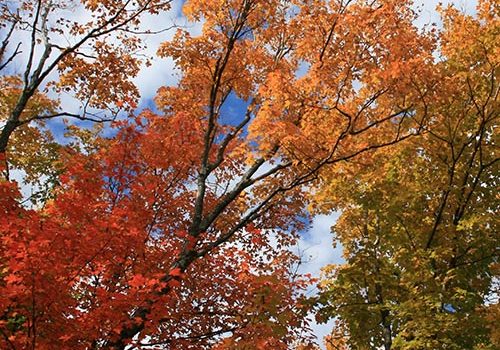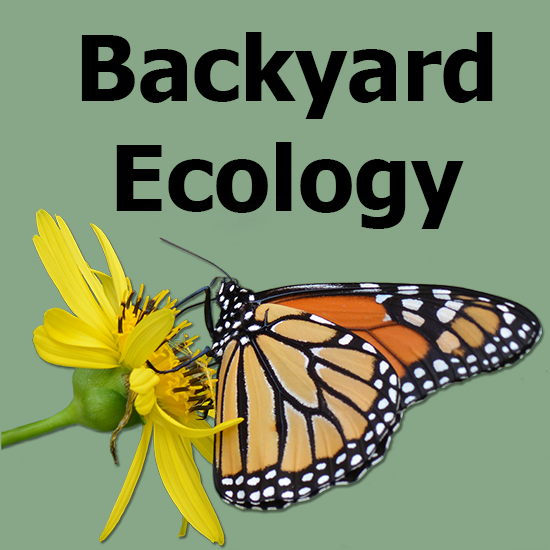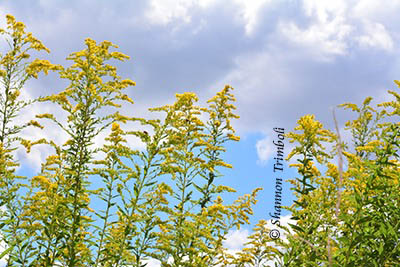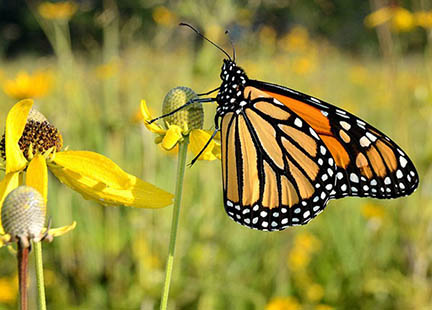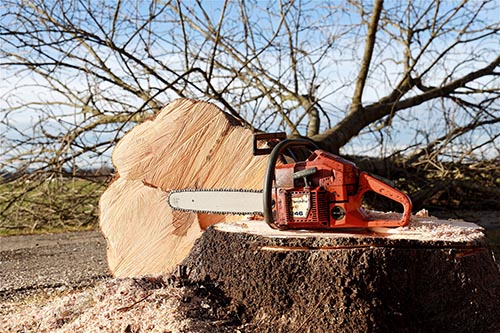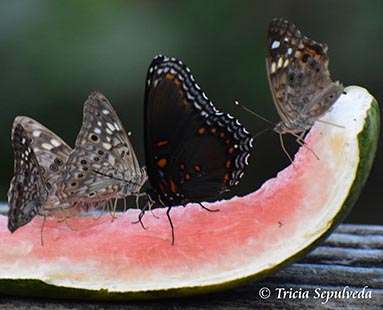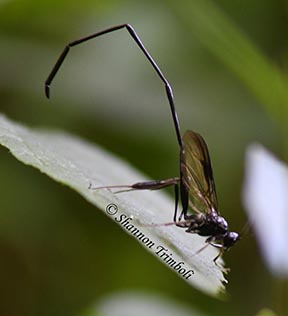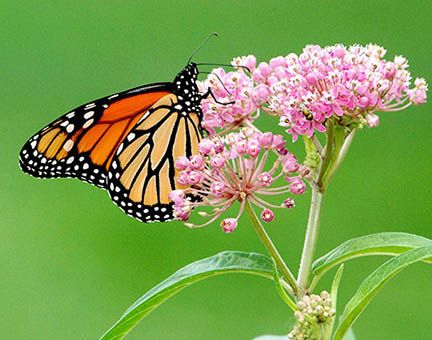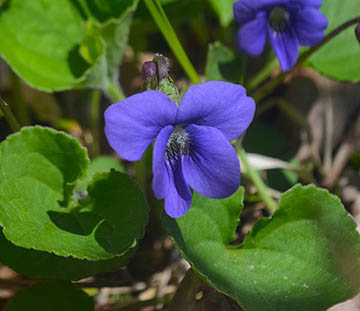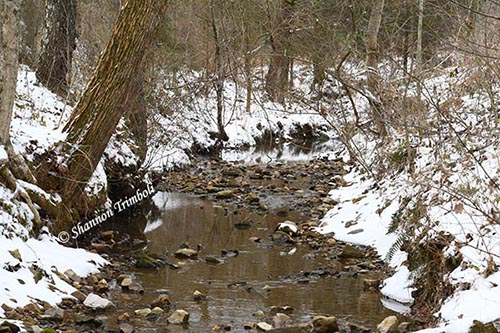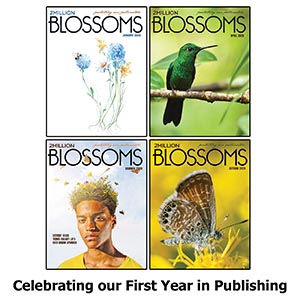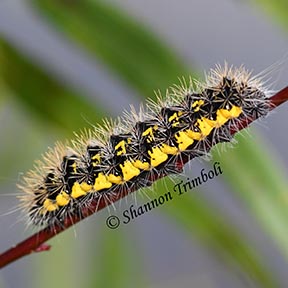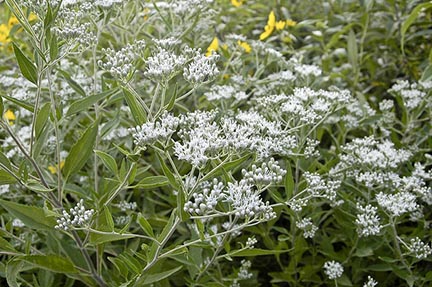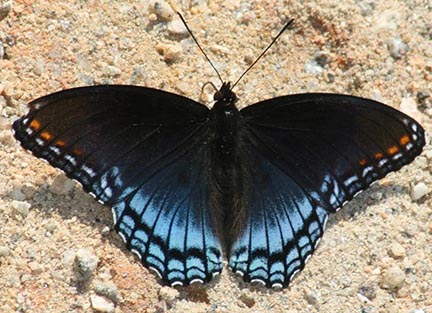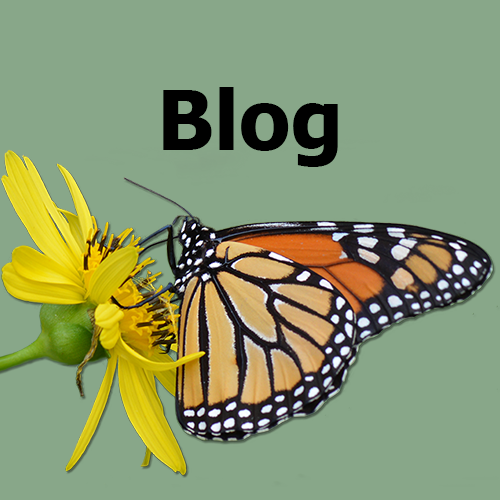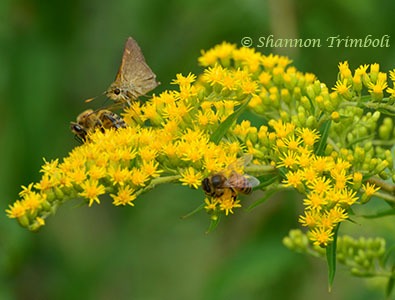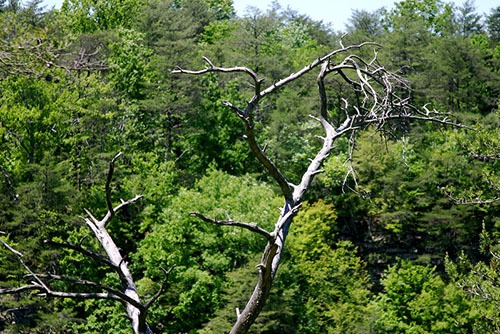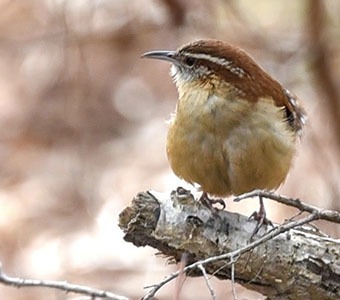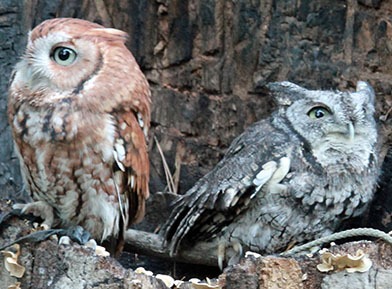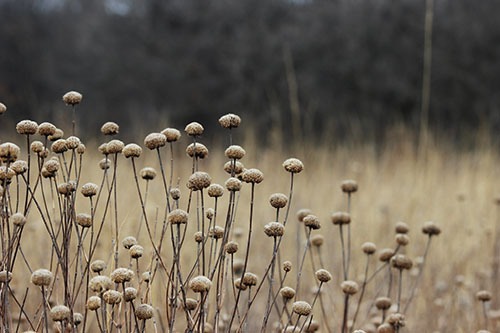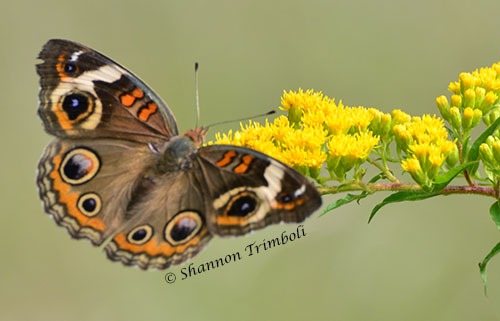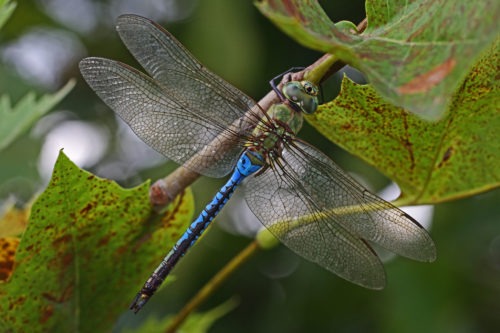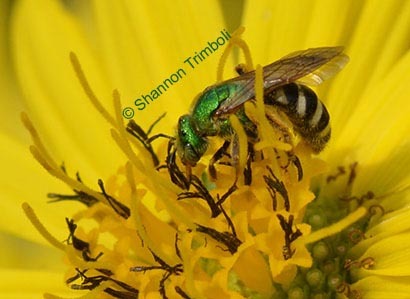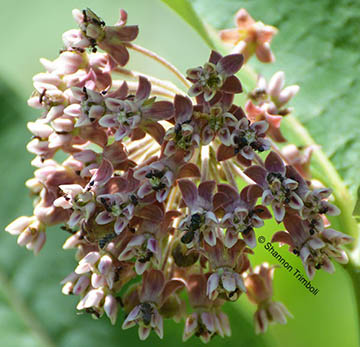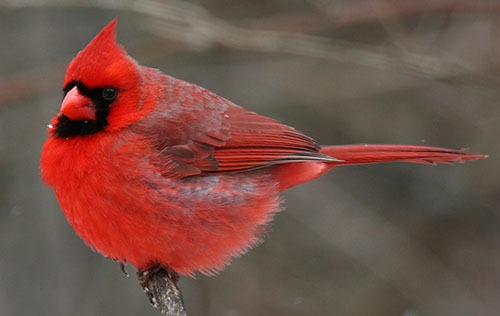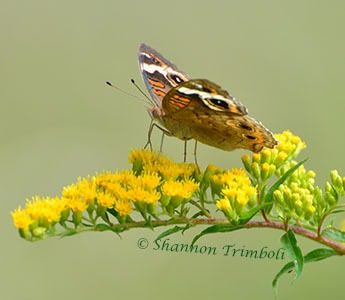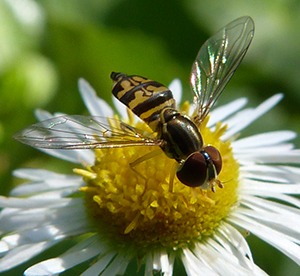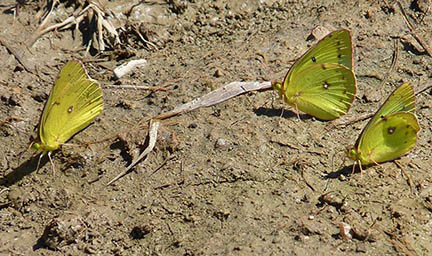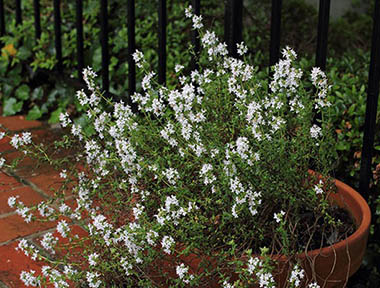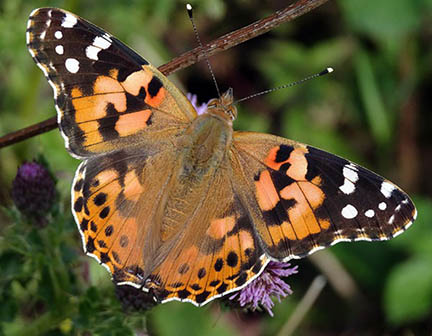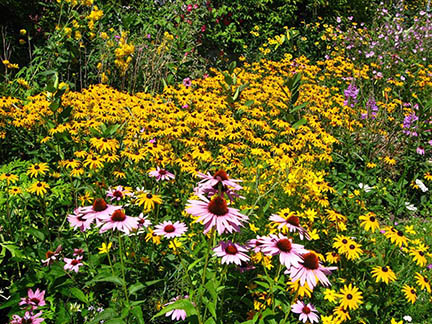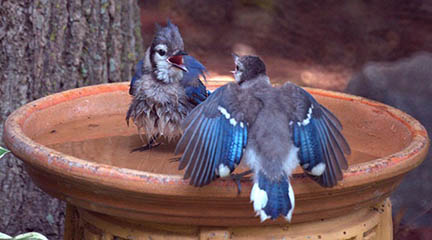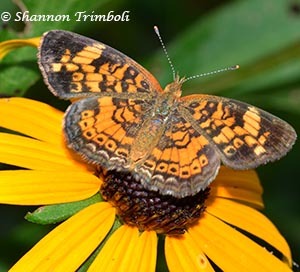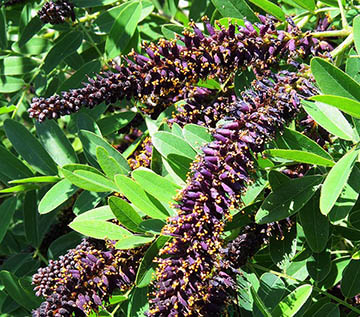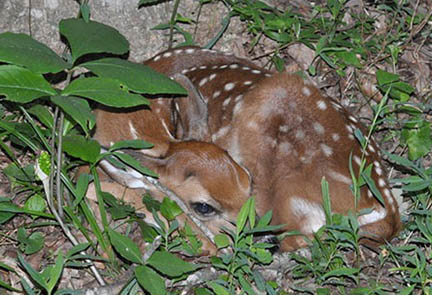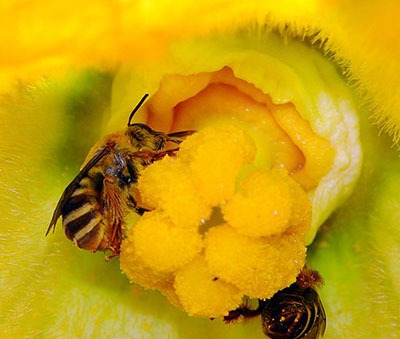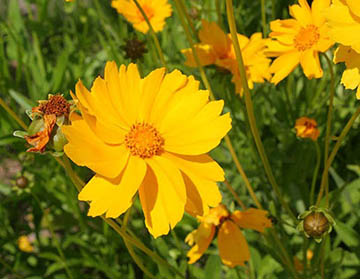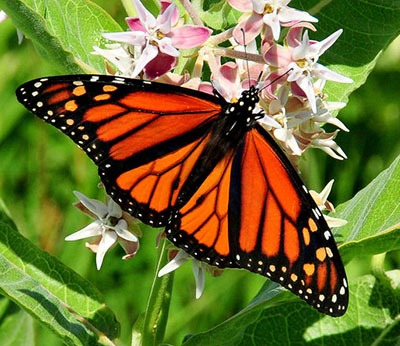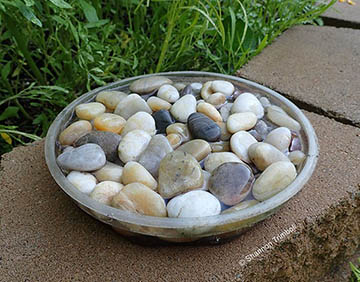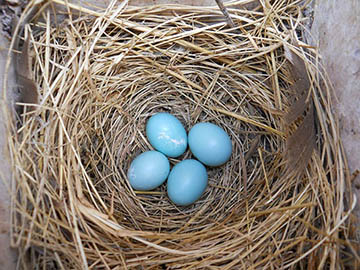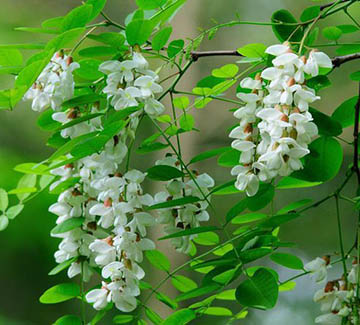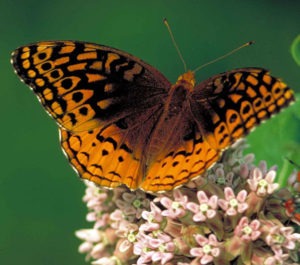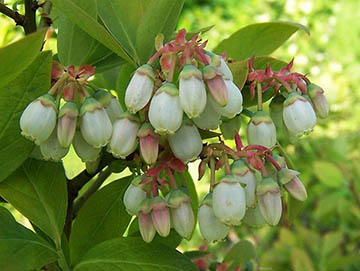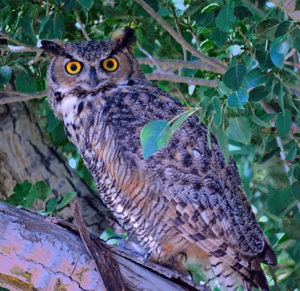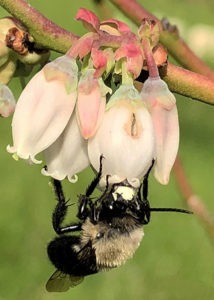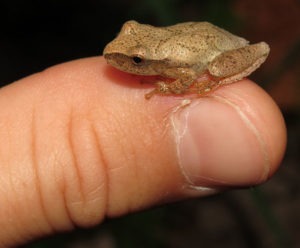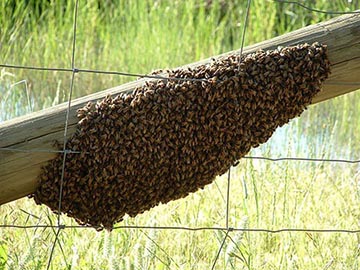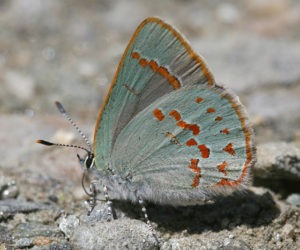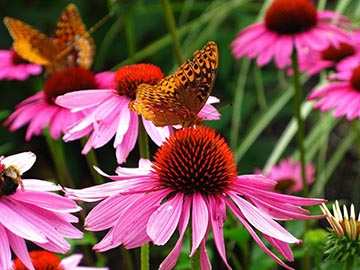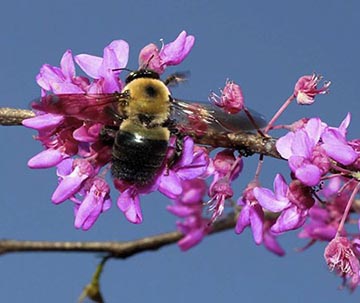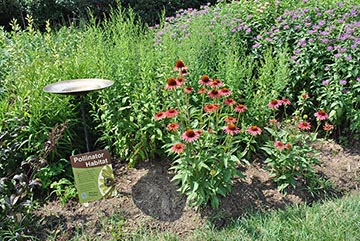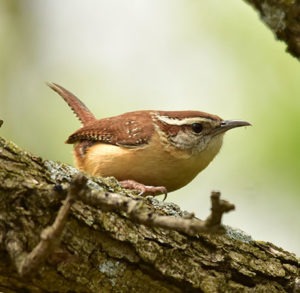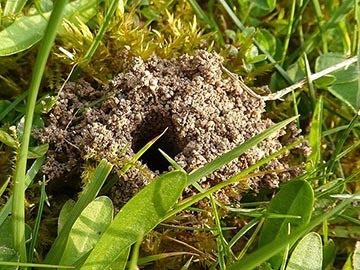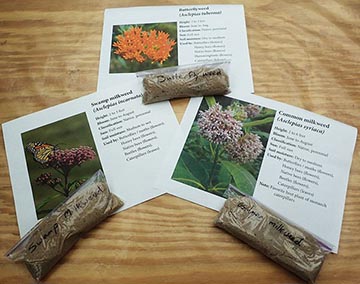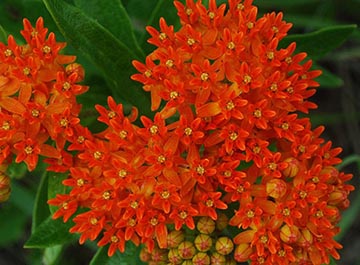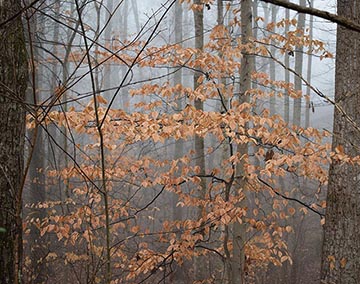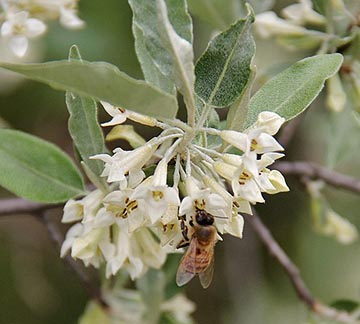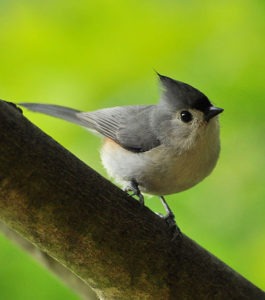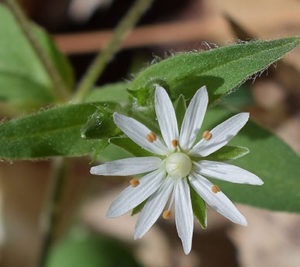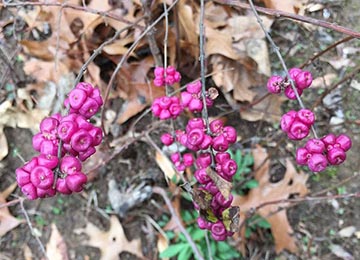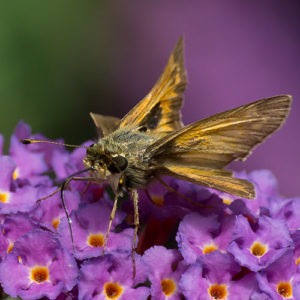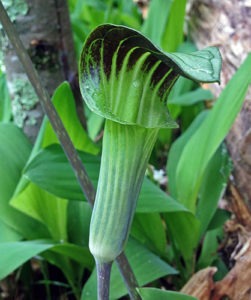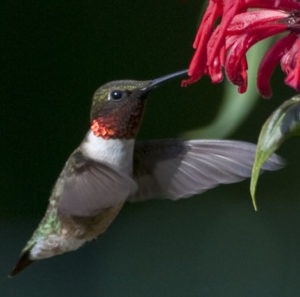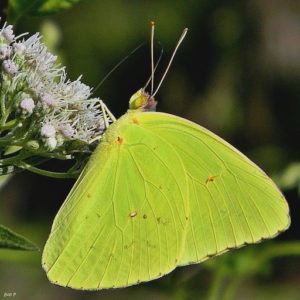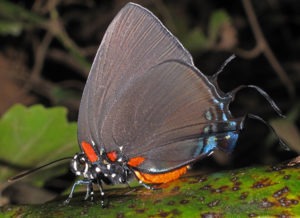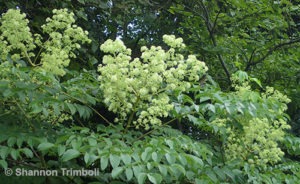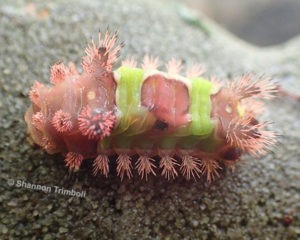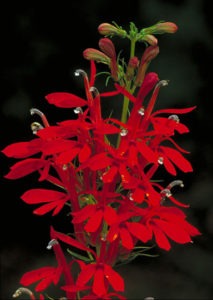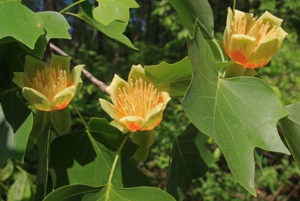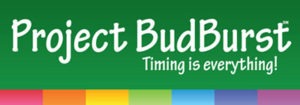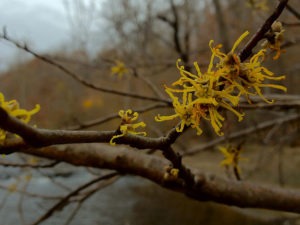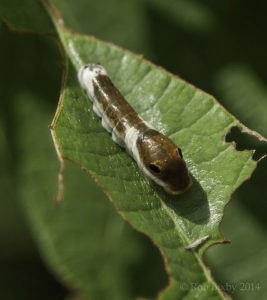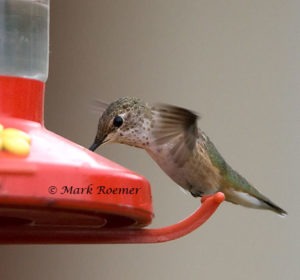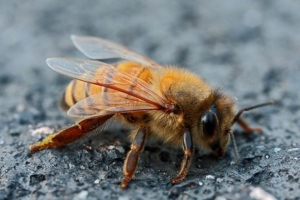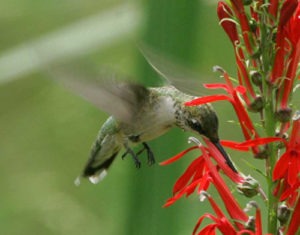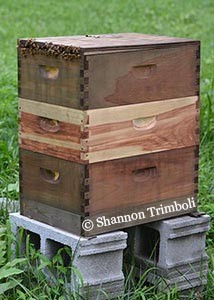Posts
We review the top 10 Backyard Ecology podcast episodes published between Oct. 1, 2022 and Oct. 1, 2023 based on the number of downloads.
The Backyard Ecology YouTube channel was started in the spring of 2022. We review the top 10 shorts on that channel as of Thanksgiving 2023.
A review of the top 10 Backyard Ecology blog articles published between October 2022 and October 2023 plus a bonus of the most viewed article of all time.
The Backyard Ecology YouTube channel was started in the spring of 2022. We review the top 10 videos on that channel as of Thanksgiving 2023.
Shannon Trimboli, Neil Diboll, and Hilary Cox discuss growing native plants in garden settings and the new book, The Gardener's Guide to Prairie Plants.
Shannon Trimboli and Brainard Palmer-Ball discuss winter hummingbirds in the eastern U.S. including what to do if you find one and how common they are.
When gardening with native plants for pollinators and wildlife, the traditional fall cleanup of the garden is not only unnecessary but could be detrimental.
In this Backyard Ecology episode we talk with Jennifer Ceska from the Georgia State Botanical Garden at UGA about gardening with native plants and much more.
The secret to building a thriving ecosystem in your yard or community is to understand and embrace the concept of "it depends."
Backyard Ecology now has a new membership community and group coaching programs to help people at a deeper level through all stages of their ecological journey.
I remember Dad hanging our first tube feeder on the front porch. He filled it from a special bag of seed, not the sunflower seeds that we fed to all the other birds that came to our feeders during the winter. These were much smaller and elongated – “thistle seeds” […]
Navigation Menu Audio Links Sara’s links: Other episode-related links: * Amazon links are affiliate links. Backyard Ecology links: Back to top Full Transcript Intro: Did you know that urban ecology doesn’t just apply to big cities and towns? Even if you live in a fairly rural area, if there is […]
Storms are a powerful force of nature. The rain nourishes the land and stimulates life and growth. The wind can bring much needed relief from the stifling heat and humidity of summer. But the wind and rain can also cause flooding, knock out power, topple large trees, and create other […]
Did you know that there are approximately 10 times more moth species worldwide than there are butterfly species? Or that without moths we would have fewer songbirds, less genetic diversity in many of our native plants, and lower harvests of many popular fruits? Or that creating better moth habitats around our homes also benefits our health and wellbeing?
Anthony and I both had big plans for this week. A blog article to write and record. At least one “long” video and hopefully a shorter nature trivia video or two to create. A podcast episode to edit. Work on multiple projects that we’re planning to launch before the end […]
Navigation Menu Audio Links Episode links: * Amazon links are affiliate links. Backyard Ecology links: Full Transcript Intro: If you’ve ever found a plant that you didn’t recognize and wanted to know what it was, then this episode is for you. We talk about learning to observe plants, how to […]
If you are interested in attracting butterflies to your yard, then you aren’t alone. Many people dream of having lots of beautiful butterflies flitting across their property. To accomplish your dream of attracting butterflies, you may be thinking about planting a butterfly garden or you may have already planted one. […]
Did you know there is a group of native plants which can be highly adaptable, can serve multiple functions in our gardens, and perhaps even be a backbone component to our home landscapes, but which has historically been overlooked for those purposes? This group of native plants is the sedges, […]
For the past few years as April winds down and we enter the month of May, the memes and articles promoting No Mow May seem to explode and are practically everywhere. It’s also something I commonly get asked about when I’m giving presentations or talking to people about making their […]
As spring starts to roll around, the garden centers, greenhouses, and nurseries fill up with seeds, bulbs, and pots of brightly colored plants in full bloom. It’s a scenario that plays out every year in just about every town or city. At the same time, the weather is warming up […]
Do you want to start growing native plants in your yard, but don’t know where to find them? Or maybe you aren’t even sure what a native plant is for your area. Or maybe you are in a situation where you can’t plant anything right now, but you still want […]
This past February and March were quite eventful and packed full of nature-related discoveries and observations. For starters, it seemed like many of the late winter blooming trees and early ephemeral wildflowers bloomed a little on the early side. Then, at least where I’m at, March’s weather was insane with […]
Birding is a fun activity with many different ways you can do it. You can bird by ear and identify birds by their songs. You can look at the birds and identify them that way. You can watch the birds out your window or as you spend time in your […]
When most people think of bees, the non-native honeybee and the native bumble bees are what often come to mind because they are big and easily recognized. But there are thousands of other, lesser known species of native bees. Some of the most interesting are the many species of ground […]
Do you enjoy having birds nest on your property? Would you like to learn more about what to look for in a nest box to make it the best it can be for your birds? Are you interested in finding out how you can safely monitor your nesting birds and […]
Do you struggle with invasive species on your property? Or, have you ever wondered, what’s the big deal with invasive species? Why are they so bad? Or maybe you just wondered how our invasive species got here. After all, if they are so awful, then why would anyone bring them […]
By: Anthony Trimboli When we think of native shrubs that have four season interest the hollies often come to mind. Their bright red berries, spring bloom and foliage are all hard to beat when it comes to looking good in the landscape. But there is another alternative to the hollies […]
Lawn care probably isn’t the first thing you think of when you think about backyard ecology. Honestly, it isn’t for me either. But it is something that most of us have to deal with in one way or another whether we do it ourselves or hire someone to do it […]
The American woodcock (Scolopax minor), also known as the timberdoodle, is a funny looking bird. It can be found throughout most of the eastern U.S. and southeastern Canada during at least part of the year. Every year I look forward to hearing their familiar “peents” and watching their sky dances […]
You know how sometimes you’ll meet someone and things just “click?” You quickly discover that you have lots of shared interests and experiences and your conversation just flows as it goes down one path and then the next. Well, that’s exactly what happened in this episode as I talked with […]
I hope you had an amazing holiday season and your new year is off to a wonderful start. I also hope that over the last couple of months you were able to make some time to get outside, relax, and enjoy some of the nature surrounding you. Below are a […]
Have you planted a meadow or pollinator planting on your property? Or, do you know someone or some place in your community that has one? If it’s on your property then part of the recommended management for it may have been to mow it periodically. Or if it’s not on […]
Browse seed catalogs or walk into almost any big box store’s garden center and there is a good chance that you’ll find one or more seed mixes for sale that are labeled as “wildflower blends.” Some are even marketed as good for pollinator gardens. But just because something is a […]
Do you want your yard to benefit nature, while also being a place that speaks to you and is somewhere you enjoy spending time? Would you love for your yard to also be a place your neighbors admire and that inspires them to create pollinator and wildlife friendly landscapes? In […]
The new year is only a few days away. As I said in last week’s podcast episode, this is traditionally a time for looking back over the last year and looking forward to the new year. We’ve been following that tradition in the Backyard Ecology world, both with our content […]
Over the past year, we’ve had some amazing conversations with a variety of highly talented and passionate people. I am very grateful to them for sharing their enthusiasm and knowledge with us. What was your favorite episode of the year, and why? Please let us know in the comments. For […]
When I was a kid, downy woodpeckers were common visitors to our suet feeders and the platform feeder that held black sunflower seeds on the front porch. So, I had lots of opportunities to watch them. They were probably the second species of woodpecker that I learned to identify. (The […]
The Christmas Bird Count, also known as the CBC, began in 1900. For the past 122 years, volunteer birders of all ages and abilities have gathered together to conduct surveys of the birds found in their areas. The Christmas Bird Count is the longest running, community science or citizen science […]
When we think about early winter interest in the garden or landscape, we are often thinking about trees or shrubs that have interesting bark or brightly colored berries. Native grasses can also provide early winter interest with their golden browns and attractive seedheads. However, rarely do we think about herbaceous […]
The holiday seasons are upon us. This is often a time to gather with family and friends, give thanks, share memories, exchange gifts, and reflect both on what we have and what we hope to achieve in the coming year. I thought about skipping this episode completely since it will […]
Around here it was an amazing fall – full of fall wildflowers, late season pollinators, and beautiful fall colors. We were seeing and hearing reports of butterflies well into the first week of November! Then the seasons changed, almost overnight, as we were plummeted into early winter. However, I wouldn’t […]
Wasps are often portrayed as one of “the bad guys” in the insect world. But part of that common misconception comes from a lack of knowledge or understanding about wasps in general and stereotypes that don’t apply to most wasp species. The truth is that wasps are extremely diverse and […]
By: Anthony Trimboli When it comes to native nut producing trees and shrubs the oaks get most of the attention. The mostly gone but not forgotten American chestnut also gets a ton of press, even though there is no blight resistant variety available – yet. While trees are excellent nut […]
Monarch butterflies have become an increasingly hot topic in recent decades, and especially in the last couple of years. Conversations about monarchs often revolve around topics like their migrations, the importance of milkweeds, or other flowers we can plant for monarchs. Rarely do the topics of monarch health or monarch […]
Bats are an important part of the ecosystem. In the eastern U.S., all of our bats are insectivorous which means that they eat insects. Many of the insects they eat are ones that we would consider pests. Unfortunately, populations of many of our bat species are declining for a variety […]
One of the most common pieces of advice given related to pollinator gardening is to try and have a constant supply of blooms available throughout the growing season. That’s easy in the spring. The summer is a little more challenging than the spring, but is still relatively easy. Even early […]
One of the many things I love about the fall is watching all the cloudless sulphur butterflies (Phoebis sennae) flying across our yard and fields. They always remind me of little drops of sunshine fluttering through the air. Cloudless sulphurs can be found in most of the eastern U.S. They […]
Have you ever found a leaf with weird little balls or spiky things attached to it? Or found a plant with a weird growth on its stem or a dense clump of leaves growing out of an odd place? Chances are those were galls. Going into this conversation, I knew […]
I absolutely love fall! The temperatures are much nicer. The fields are a riot of color – lots of bright yellow, of course, but also purples, whites, pinks, oranges, and scattered other colors. Goldfinches are everywhere. And then there are all the butterflies, bees, wasps, and other “bugs” busily going […]
One of the most common questions I get is, “What should I plant for pollinators?” As you’ll hear in today’s conversation, I’m not the only one who frequently gets that question. It’s probably the most common question asked of anyone who promotes pollinator gardening. Unfortunately, there isn’t a simple answer […]
Property owners and land managers will often mow large fields in the fall. Sometimes this is done for aesthetic reasons. Sometimes it is done because “that’s the way it’s always been done.” And sometimes it is done out of a desire to keep trees and other woody vegetation from taking […]
We’ve all been there. We are walking in the woods, in a field, along a creek bank, around our property, or around the local park and we stumble upon an interesting plant. It isn’t one that we know and we immediately begin to wonder, “what is that?” It’s a simple […]
Ironweeds are perennial, native wildflowers that produce beautiful, purple blooms about the time the goldenrods start to light up the fields. There are approximately 15 different species of ironweeds (Vernonia spp.) in the eastern U.S. with more out west. The most widespread species in the eastern U.S. is tall ironweed […]
Fall is an extremely important time for pollinators, so having plenty of flowers available at this time of year is crucial if one of your goals is to attract pollinators. Luckily, there are lots of fall blooming, native plants that you can grow in your gardens. In the last Backyard […]
Every summer, about the time that the annual cicadas start calling, one of our largest wasps appears. They can be kind of intimidating because of their size. Their yellow, black, and reddish-brown coloration only adds to their menacing look. These wasps are called cicada killers, and unless you are a […]
Late summer is often thought of as a challenging time for gardening. It’s hot, it’s humid, we may or may not be getting regular rainfall, and there are often lots of other summertime activities competing for our attention. But if our goal is to plant for pollinators and wildlife, then […]
On July 21, 2022, the IUCN listed the migratory population of the monarch butterfly as endangered on their Red List of Threatened Species. Monarch butterflies are so familiar and so beloved that the reaction was immediate and passionate. In many cases, it was also misinformed. So, let’s dig in a […]
I often hear comments or questions such as, “I do what I can in my yard, but I wish more people in my community would plant pollinator gardens.” Or, “What can I do to get my community involved and to make my community more pollinator friendly?” It can feel overwhelming […]
The last month or so has been incredibly hot, dry, and humid where I’m at. Heat indexes of over 100 have become normal. I’m very grateful for all the wildlife that I can view from the house while sitting in the air-conditioned comfort on those hotter days. Yet, even with […]
Did you know that Venus flytraps are insect pollinated? Or that they are native to a very small part of eastern North and South Carolina? Or that they rarely eat flies? I didn’t either until I stumbled upon a research paper talking about the pollination of Venus flytraps. That paper […]
Hummingbirds are fascinating and common visitors to our yards. Attracting and feeding hummingbirds is a favorite activity of many people. The internet and social media are full of advice for attracting and feeding hummingbirds, and like for most topics, some of the information is good and some isn’t. In fact, […]
Summer brings with it butterflies, lightning bugs, caterpillars, hummingbirds, fawns, baby birds, and so much more. It can be a really fun time to just get outside and observe all of the fascinating plants and animals around us. There are also plenty of things that we can be doing at […]
Introduction Buttonbush (Cephalanthus occidentalis) is a deciduous shrub native to the eastern half of North America. It can be found growing naturally along creeks, ponds, lakes, and other fairly wet areas. Buttonbush can also be grown as a native ornamental in mostly sunny areas where the soil is on the […]
I often get asked what people can plant for bees. I can give good general answers to those questions, because we have a good idea of what types of flowers tend to be attractive to bees in general. We can then use that information along with personal observations made by […]
Have you ever caught a quick glimpse of a tiny “hummingbird” hovering around a flower? Then realized that not only was it too small, but it also wasn’t the right colors and wasn’t producing the characteristic hum. Perhaps it looked like a hummingbird and a bumblebee had a baby. Don’t […]
Glades are ecosystems where the soils are really shallow and rocky, often with patches of rock showing on the surface. They can be found all over the world, including multiple states within the eastern U.S. These ecosystems are unique areas that support some really interesting and sometimes highly specialized or […]
Where did this spring go? The last couple of months have been crazy busy, but so much fun too. I have had the opportunity to make some amazing nature-related discoveries both around my own property and while traveling. Below are a few of the nature-related discoveries I’ve made on our […]
I can’t believe that I’ve been podcasting for a year and a half and that this is my 50th episode of the Backyard Ecology podcast! I am truly honored and humbled that so many people enjoy hearing what I have to say and are following the podcast. Looking back, we’ve […]
Growing native plants is one of the best things you can do to attract pollinators and wildlife. However, if you’ve ever grown native plants either in your garden or in a larger pollinator planting, then you may have noticed that some species are very slow to take off. In fact, […]
The interest in gardening with native plants has been growing steadily, and I am very excited about that fact. Growing native plants in our gardens and landscapes can have many benefits – both for us as the gardeners and for the pollinators and wildlife that also call our yards home. […]
Introduction Anise hyssop (Agastache foeniculum) is a perennial native wildflower for parts of the northern half of the U.S. and into Canada. Some resources, such as the USDA Plants Database, consider it native to Kentucky. Other resources consider it adventive (likely escaped from cultivation) in Kentucky. No resources have it […]
Once upon a time, the moon was the brightest object in the night sky followed by the stars. However, that’s no longer the case. Today the night sky is so brightly lit by artificial lights sources that the majority of people living in North America can no longer see the […]
I used to think that there was only one type of firefly. I think many of us go through that stage. Looking back, I have to laugh because why would there only be one type of firefly? I mean, we have more than one type of bird, butterfly, frog, fish, […]
Ruby-throated hummingbirds are common and much beloved summer visitors to yards and gardens throughout the eastern U.S. and Canada. In this episode of the Backyard Ecology podcast, we talk about ruby-throated hummingbirds, their northward migration, and how to make our yards more hummingbird friendly. We are joined in this conversation […]
It’s spring! The days have been getting noticeably longer. The birds are starting to sing in the mornings. The spring ephemeral wildflowers are starting to bloom. Spring tree top flasher firefly larvae are on the tulip poplar trunks. The first butterflies of the year are coming out. And the phoebes […]
Grassland birds such as bobwhite quail, meadowlarks, sparrows, northern harriers, burrowing owls, and many others represent one of our fastest declining groups of birds. In many ways, this makes sense since grasslands are some of our fastest declining ecosystems, especially in the eastern U.S. Yet, many people don’t realize how […]
By: Anthony Trimboli Background Poison hemlock (Conium maculatum) is an invasive weed that is found throughout the United States. It is commonly seen growing along roadsides, in ditches, and other disturbed areas with moist soils. Poison hemlock grows as a biennial in the colder portions of the U.S. That simply […]
The spotted lanternfly (Lycorma delicatula) is an invasive species of leafhopper (a type of insect) that was accidentally brought to the U.S. from Asia. It was first detected in Pennsylvania in 2014 and has spread to multiple states since then. This episode of the Backyard Ecology podcast is all about […]
Introduction Red maple (Acer rubrum) is a medium height tree that can grow up to 100 feet tall. It is native to most states in the eastern half of the U.S. and much of eastern Canada. Red maple is one of our earliest blooming native trees and can be an […]
When it comes to planting for pollinators or gardening for pollinators, the traditional advice has always been to plant larger patch sizes or clumps of plants. The thought is that the larger patch sizes will be easier to see and more attractive to pollinators than smaller clumps or patch sizes. […]
Overview Skunks may not be the first animal that pops into your mind for backyard wildlife, but they are common visitors to many yards. Because they are active at dusk and during the night, they often go unobserved. Despite their infamous defense mechanism, they don’t have a very strong smell […]
In 2021, Kyle Lybarger began creating TikTok videos about native plants and grassland ecosystems in Alabama. He quickly became a social media star and even gained the attention of more traditional media streams including The Weather Channel. Kyle is doing terrific work teaching about and raising awareness of native plants […]
Weather-wise, the last couple of months have been insane. In early December, I still had a few scattered goldenrods in bloom. They were all individuals that had been browsed or cut earlier in the year, which kept them from blooming at the same time as the other goldenrods. I was […]
Sometimes you read or hear something that makes you say, “Wait a minute! What?” It was one of those moments that led to this episode. In this episode of the Backyard Ecology podcast, I talk with David Mason. David is a PhD candidate at the University of Florida who has […]
Trees can be valuable components of our ecosystems, not to mention the cooling and other benefits they can provide around our homes. But sometimes you may need to cut down one or more trees. From a wildlife perspective, the best time to cut down a tree will be in the winter. All else being equal, I prefer removing trees in the early to mid-winter, rather than later in the winter.
Winter is often depicted as being dark and cold. A time to slow down and spend more time inside, than outside. But winter can be a really great time for observing nature and doing many habitat management activities. Habitat management activities that we can do in the winter is a […]
I officially launched the Backyard Ecology blog in September 2020. Over the past 16 months, I’ve written over 50 Backyard Ecology blog articles, in addition to producing Backyard Ecology podcast episodes. The blog articles have covered a wide variety of topics, but generally can be grouped under 4 main categories: […]
The first “real” episode of the Backyard Ecology podcast went live on December 3, 2020. (Technically that was episode 2, but I don’t count the introduction episode as a “real” episode because all I was doing was telling you that I was going to start the Backyard Ecology podcast.) This […]
Overview Sometimes when we are walking through our yards or communities, we don’t see the critters themselves as much as we see the signs they leave behind. Such is the case with the goldenrod gall fly (Eurosta solidaginis). Goldenrod gall flies can be found throughout most of North America. There […]
Lichens are AMAZING organisms. You can find them practically everywhere from very urban areas to very rural areas. You can find them growing on trees, rocks, buildings, benches, and all kinds of different things. But many of us really don’t know a whole lot about lichens. In today’s episode of […]
It’s hard to miss the basketball-sized clusters of green leaves decorating the bare upper branches of trees as they reach up to the winter sky. Those basketball-sized clusters of leaves are most often mistletoes. There are several different species of mistletoe in North America, and even more in other parts […]
Wild turkeys are fascinating birds that are only found in North America. They are also a conservation success story – one which most people aren’t aware of because the turn-around was so successful. In this episode of the Backyard Ecology podcast, we talk with Dr. Bret Collier. Bret is a […]
What a difference a couple of months have made! The leaves have fallen off the trees and I can once again see the road from my house. The fall warblers have migrated through and my winter suite of birds are arriving. The flowers have stopped blooming and beautiful seed heads […]
When it comes to gardening for monarchs, the most common thing you hear is “plant milkweeds.” Milkweeds are important, because they are the only thing that monarch caterpillars can eat. But they aren’t the whole story. In fact, having other types of flowering plants available can actually make your gardens […]
Think of fall in the eastern U.S. and fall foliage is likely to be high on the list of things that comes to mind. People will drive for hundreds of miles to admire a forest ablaze in bright red, orange, and yellow leaves. More than one vacation, wedding, or other […]
Bats are often associated with Halloween and relegated to roles in scary movies, but they are so much more. Bats are very diverse and fascinating creatures that play an invaluable role in our ecosystem. I love the fact that more people seem to be recognizing this and wanting to do […]
Walking through my woods, I was excited to find a clump of ground cedar. My grandparents introduced this plant to me when I was kid, but they taught it to me by one of its other common names – running cedar, and I still sometimes call it that. To this […]
We always think of hummingbirds as being summer birds. But, did you know that we also have winter hummingbirds? They aren’t common, and they become less common the further you are from the southern coastal plains; however, they aren’t unique either. In the winter of 2011-2012, I was lucky enough […]
Overview Woolly worms, also known as woolly bears, may be our most familiar and well-recognized moth caterpillar. Every fall we see them steadily marching across driveways and streets in search of a place to spend the winter. And every year, predictions are made about what the upcoming winter is going […]
What happens when you do a shelterwood cut, conduct a prescribed burn, or have some other natural or human-made disturbance event in oak hickory forests? What happens to the acorn crop? How do different types of wildlife respond? What about the other vegetation in the woods? In this Backyard Ecology […]
It’s been a while since I shared some of my nature-related discoveries with you. So, I thought it was about time to do it again, especially since I found and was able to observe so many fun and cool nature-related discoveries in August and September. Below are just a few […]
Sometimes it’s just fun to sit down and have a fun conversation with other people in the industry, and that’s exactly what we did in this episode of the Backyard Ecology podcast. In this episode, I talk with Fran Chismar and Tom Knezick. Fran is the Sultan of Sales for […]
When planting for pollinators, the general advice is to have at least three different things blooming throughout the growing season. For most of the spring, this is easy because it seems like everything is in bloom and everyone has some sort of flowering plant in their yard. I could easily […]
Pollinator gardens have rapidly increased in popularity, but unfortunately, there hasn’t been a lot of research on the best ways to create those gardens or on how effective those gardens really are. Happily, that’s beginning to change. More and more scientists are beginning to tackle those types of questions in […]
Have you ever been walking in August or September and noticed a tree with a few scattered red leaves? You may have thought “that’s weird,” because obviously it is still way too early for the leaves to be turning colors. If so, you may have been looking at a black […]
If you listen to the Backyard Ecology podcast, then you are likely interested in creating pollinator and/or wildlife habitat on at least part of your property. The Natural Resources Conservation Service or NRCS is a federal agency that has a number of programs which can help us do just that. […]
Overview Velvet ants aren’t really ants at all, but instead are a type of wasp. There are thousands of species of velvet ants worldwide with over 400 species being found in the continental U.S. and Canada. According to the University of Florida, 50 species can be found in that state […]
In the spring of 2021, reports started coming in of birds dying with weird eye and/or neurological symptoms. At first, it seemed like the bird mortality event was only in Washington, D.C., Maryland, and Virginia, but before long reports began to also come in from West Virginia, Delaware, New Jersey, […]
June and July have been busy months filled with tons of nature-related discoveries! I missed most of our early lightning bug species, but they were insane in June and July. There were several nights when I picked out at least half a dozen different flash patterns. Each of those would […]
Lyme disease is our most common tick-borne disease and it is estimated that there are around 400,000 cases each year. Black-legged ticks or deer ticks (Ixodes scapularis) are the only species of tick that carries Lyme disease in the eastern U.S. Although deer ticks are found throughout the eastern U.S., […]
We always think about growing flowers when we think about attracting butterflies to our yards. Or, if we’re thinking about the bigger picture, we think about flowers and host plants so that we are feeding both the adult butterflies and their caterpillar babies. However, what many people don’t realize is […]
New England aster (Symphyotrichum novae-angliae) is a late summer / early fall blooming wildflower that is native throughout most of North America. In the last decade or so, it has become a fairly common plant to include in native plant and pollinator gardens, as well as, in larger habitat restoration […]
I’ve always really enjoyed looking at the pictures and watching the videos captured by the trail cameras on our property. The videos are always my favorite because you get to see more of the behaviors. Either way, retrieving the SD card from a camera is always exciting because you just […]
One day, late last summer, I decided to see how the berries were developing on the devil’s walking stick (Aralia spinosa) at the back of our property. The devil’s walking stick patch grows along the edge of the woods next to one of our fields. It was sunny, hot, and […]
This episode is different from anything I’ve done before, because Michael Hawk, who hosts the Nature’s Archive podcast, and I are sharing each other’s episodes. One of the things I really like about the Nature’s Archive podcast is that in addition to the biology, Michael also digs into the stories […]
This has been a crazy year. The temperatures in May seemed cooler than normal to me and it was relatively dry overall. I mean, we would get a gully washer of a storm, then nothing….. until another gully washer came. We definitely didn’t seem to get the frequent, gentle May […]
Laurel wilt disease is a disease caused by an introduced beetle and fungus. This disease is deadly to members of the Laurel family which includes redbay, sassafras, and spicebush. Laurel wilt disease also kills avocados, which aren’t native to the eastern U.S., but are in the Laurel family and are […]
I’m often asked what is the best species of milkweed to grow for monarchs. In many ways, the answer is whatever species is native to your area and has the tastiest leaves for the monarch caterpillars to eat at that particular instant in time. Let’s talk about that statement for […]
I know from the emails and messages that I’ve received that many of you are parents, teachers, grandparents, aunts, uncles, or friends of young people. Well, this episode is for all of you. In this episode of the Backyard Ecology podcast, we talk with Heather L. Montgomery. Heather is an […]
White prairie clover (Dalea candida) is a native, perennial wildflower throughout most of the Midwest and central U.S. The eastern edge of its native range crosses the Mississippi River and includes Illinois, Kentucky, Tennessee, and Georgia. White prairie clover is also commonly grown in garden settings outside of its native […]
Thank you for joining me on this Backyard Ecology journey. I can’t believe we’re already up to episode 24 of the Backyard Ecology podcast! And the blog has been going on, in one form or another, for much longer than that. I am really looking forward to continuing on this […]
If you are in the eastern U.S. and find a turtle in your yard, there’s a good chance that it is a common box turtle (Terrapene carolina). Box turtles are also the turtle that you are most likely to stumble across out in the woods, or even on a hike […]
For many of us, the rhythmic chatter of annual cicadas is a natural part of every summer. But then… every once in a while… the trees explode in a deafening chorus of periodical cicadas. Periodical cicadas will spend over a decade as nymphs underground before emerging and maturing into adults. […]
This is always such an exciting time of year. The wildflowers are blooming. The insects are appearing again. The birds are starting to sing their dawn chorus in the mornings again. And the spring warbler migration is in full swing. Things are changing almost daily. There is always some new […]
Gardening with native plants has been growing in popularity. Some people want to grow native plants for plant conservation purposes or to showcase the diverse, local flora of their region. Others want to grow native plants for the benefits they provide to pollinators and wildlife. Still others are interested in […]
We all have different aesthetic views. That’s part of what keeps all of our gardens interesting and makes them uniquely our own. Some of us like our beds to be very neatly maintained with expanses of wood mulch separating out each group of plants. Others like to use gravel to […]
Eastern bluebirds are a conservation success story. Their numbers plummeted in the early 1900s. Then in the 1960s and 70s, consorted efforts were started to establish bluebird trails and similar programs. Growing up in the late 1970s and 1980s, I remember often hearing about the plight of the eastern bluebird […]
General Biology and Life History of Culver’s Root Culver’s root (Veronicastrum virginicum) is an herbaceous perennial that is native to most of the eastern U.S. and parts of eastern Canada. It is much more common in some states than others. Culver’s root grows naturally in moist to wet meadows or […]
It is so easy to come home at the end of a long day, eat supper, and then just sink into the couch to veg out for a bit or keep ourselves busy with household activities that need to be done. I’ll be honest, I’m as guilty as the next […]
The giant leopard moth (Hypercompe scribonia) can be found throughout most of the eastern United States. It is a beautiful moth that is fairly easy to observe. Giant leopard moths also have some surprising characteristics that make them fun to learn about. What does it look like? Adult Adults are […]
I am frequently asked about growing native plants in small spaces or in typical suburban yards with HOA or city ordnances. And I’m not the only one who’s getting those questions. I hear and see those same questions being asked throughout the native plant and pollinator communities. That’s why I […]
After a crazy February and early March, spring has finally sprung! The red maples and elms bloomed at the beginning of the month. Now, the spicebushes are in full bloom and the early spring ephemeral wildflowers are starting to dot the woods. Not to mention the spring peepers are calling […]
Flower flies, a.k.a. hover flies, are common garden visitors, but they are often overlooked. The reason they are so often overlooked is because they are extraordinary mimics, usually of bees or wasps. Their mimicry is so good, that flower flies are often mistakenly identified as bees in social media posts, […]
Planting native trees and shrubs that produce berries is a great way to attract songbirds to your yard. Many of our songbirds rely on berries and other berry-like fruits for at least part of their diet. Some of our migratory songbirds, like gray catbirds, consume a significant amount of fruit, […]
Frogs and toads are so much fun to observe and learn about. In the eastern U.S. we are lucky because we have enough water that they can be found virtually anywhere. Some species may be very specific in their habitat needs, but others are fairly general and can be found […]
Take a walk in the woods in the late winter or early spring and you may find a single, green, oval leaf lying among the fallen tree leaves. I often find single leaves scattered here and there, but you can occasionally find small patches. The leaves are around 3 inches […]
This week’s episode of the Backyard Ecology podcast is the conclusion of our conversation with Lynn Faust. Lynn is the author of Fireflies, Glow-worms, and Lightning Bugs: Identification and Natural History of the Fireflies of the Eastern and Central United States and Canada. In this episode, we continue to just […]
The question mark butterfly (Polygonia interrogationis) breaks many of the stereotypes that we usually place on butterflies. In some places, you can find it flying on warm days in late February or early March. If you do see one fly by, pay close attention to where it lands. They have […]
For many of us in the eastern U.S., warm spring and summer nights are characterized by the methodical flashing of fireflies and lightning bugs. Fireflies and lightning bugs are exactly the same thing. I grew up calling them “lightning bugs,” but somewhere along the line picked up the term “firefly.” […]
Wow! February went just a wee bit crazy, didn’t it? Within about a week and a half to two weeks we had three different winter storms. (For friends and family living further north, that’s a lot of wintery weather in a short time for us.) That was after a relatively […]
Clovers are often suggested for lawn alternatives or for incorporating into our yards to make them more pollinator friendly. Clovers can also play important roles in agriculture either in grazing systems or as cover crops in row cropping systems. In addition, they are a favorite of deer and rabbits. However, […]
By: Anthony Trimboli Nandina (Nandina domestica), also commonly called heavenly bamboo, is an exotic ornamental shrub that is native to India, China, and Japan. Although not an actual bamboo, Nandina does have a cane-like growth pattern and will spread from root suckers. The dark, evergreen foliage and persistent bright red […]
Like many people, I grew up with a healthy…. apprehension (ok, fear) of wasps. And, of course, I’ve seen all the memes on social media vilifying wasps and calling them names that I’m not going to repeat on this podcast. But, those fears and concerns are mostly unfounded and misplaced. […]
Common bluets, a.k.a. Quaker ladies or azure bluets, (Houstonia caerulea) are tiny, blue wildflowers that are native throughout most of eastern North America. There are several other species of bluets that also grow within parts of eastern North America, but common bluet is arguably the most widespread and common species […]
Vernal pools are a special type of shallow wetlands that fill with snow melt and rain in late fall through early spring, then dry up sometime during the summer. Because they dry up, they are sometimes overlooked or dismissed as “not very good wetlands.” However, they serve an important role […]
Growing up in Kentucky, I commonly heard the phrase “If you don’t like the weather, wait 5 minutes and it will change.” As an adult, I learned that just about every state surrounding us has the same saying. The same thing is probably true for much of the rest of […]
The Great Backyard Bird Count is an annual citizen science / community science project hosted by the Cornell Lab of Ornithology, Audubon, and Birds Canada. This international project takes place all over the world for four days every February. In 2021, it will happen February 12-15. In today’s episode of […]
As I write this, I’m looking out my window and watching the farm turn white. We’ve really only had one other snowfall this winter that produced any accumulation and that only lasted for a couple of hours. This one will likely last longer, but I don’t expect it to get […]
We’re lucky in the eastern U.S. because bodies of water are pretty common. For most of us, if we don’t have access to a creek, stream, river, pond, etc. in our immediate backyards, then we likely have access somewhere nearby in the surrounding community. This means it can be relatively […]
Plant Hardiness Zones Pick up almost any seed packet, read almost any gardening book, or attend almost any gardening class and you are likely to see a USDA plant hardiness map. The map was developed by the USDA and is based on the average minimum winter temperatures for an area. […]
Growing native plants has grown in popularity over the last couple of decades. This has led to an increased demand for native plant seeds. However, many of us have never really stopped to think about how those native seeds are produced on a commercial level. In this episode, we talk […]
Little bluestem (Schizachyrium scoparium) is native to the lower parts of Canada and almost the entire lower 48 states in the U.S. It can be found growing naturally in barrens, prairies, savannas, and open woodlands. Little bluestem prefers drier upland sites, but is occasionally found in lower moister areas, especially […]
Land snails???? Come on, how do they fit with Backyard Ecology? True, land snails aren’t the most charismatic organism in our yards and communities, so it would be easy to just write them off and ignore them. Most of us probably do that on a regular basis. But, land snails […]
On December 15, 2020, the U.S. Fish and Wildlife Service (USFWS) “found that adding the monarch butterfly to the list of threatened and endangered species is warranted but precluded by work on higher-priority listing actions.” But, what does that really mean? And how does it affect things going forward? What […]
Many of us grew up hearing about the decline of the old growth forests and their impacts on neotropical songbirds and other wildlife. I think this was especially true for those of us who grew up here in the eastern U.S. However, the story that hasn’t been told as well […]
I hope everyone had a good a holiday season and start of the new year. December was kind of a difficult month for me this year – lots of personal stuff going on. But I was still able to get outside some and enjoy the nature around me. Here are […]
Hi Everyone! Today we are talking with Mac Callaham who is a Research Ecologist with the Southern Research Station of the U.S. Forest Service. Mac’s focus is on invasive species, with a specialty in soil animals, especially earthworms. Like many people, I grew up thinking that earthworms were a good […]
When we hear the word “wren,” many of us picture the Carolina wren because it is found year-round throughout most of the eastern U.S. and is such a vocal and animated bird. However, the Carolina wren isn’t our only wren. Besides the Carolina wren, we have four other species of […]
Hi, Everyone! In today’s episode of the Backyard Ecology podcast we are talking with Shelby Fulton who is a terrestrial biologist with the Kentucky Nature Preserves. Our conversation focuses on moths and how they survive the winter. We also talk about how diverse moths are and ways to observe them […]
For tens of thousands of people, the hustle and bustle of holiday activities also includes participating in an event that has been happening for well over a century – the Christmas Bird Count. This tradition started in North America in 1900. Since then, it has grown tremendously and has resulted […]
Hi Everyone! On today’s episode of Backyard Ecology, we talk with Maddy Heredia who is the outreach specialist and a biologist with the Kentucky Nature Preserves. Maddy and I first met when she was in college and volunteered on a citizen science / community science program that I was leading. […]
Possumhaw (Ilex decidua) has many common names including deciduous holly, swamp holly, and prairie holly. It is also sometimes called winterberry, but be aware that “winterberry” is more commonly used in reference to Ilex verticillata, which is also a deciduous holly. To make things more complicated, Ilex verticillata is sometimes […]
Hi Everyone! Today we are talking with Dr. Adam Baker who recently completed his PhD studying monarch butterflies and their use of monarch waystations in urban and suburban areas. His research has led to some important and easily applied strategies that any of us can use in our gardens. First, […]
This has been a weird November. Whether it was a beautiful bright blue sky highlighting the last of the fall leaves on a warm day at the beginning of the month or an end of the month snow shower, I’ve enjoyed getting out and making little nature-related discoveries in my […]
Hi Everyone! On today’s episode of Backyard Ecology we talk with Dr. Kirsten Traynor, a research associate at Arizona State University and the editor of 2 Million Blossoms, a quarterly magazine dedicated to protecting our pollinators. Our conversation takes a curvy, twisty path that covers multiple different topics including what […]
Butterfly boxes, also known as butterfly hibernation boxes or butterfly houses, are long, skinny boxes with thin slits usually on the front. The intent of the butterfly box is to give butterflies a dry place to go during inclement weather or a place to hibernate during the winter. (In the […]
Yellow-bellied sapsuckers (Sphyrapicus varius) are a unique species of woodpecker. At some point during the year, they can be found throughout most of Canada and the eastern half of the U.S. However, unlike our other woodpeckers, the yellow-bellied sapsucker is migratory with distinct summer and winter ranges. They also have […]
Over the last few months, I’ve been researching and working on a new project. Today I’m super excited to announce that I am launching a Backyard Ecology podcast! For those who might be wondering, a podcast is kind of like an audio version of a blog. I started listening to […]
The wavy leaf aster (Symphyotrichum undulatum) is a late blooming wildflower that is native to most of the eastern U.S. It is fairly common throughout much of its range and can be found growing wild in dry, open woods and along woods edges. Like many of our other asters, wavy […]
“What can I plant for my honey bees?” is a question that beekeepers often ask me. It’s also the question that I asked when I began my beekeeping journey. However, there isn’t a single one-size-fits-all answer to that question. Or, at least not a GOOD one-size-fits-all solution when it comes […]
Fall is my favorite time of year. I love the cooler, less humid weather, the distinctive fall smell in the early morning, the beautiful fall flowers, the busy actions of the butterflies and bees as they prepare for whatever winter looks like for them, and the transition from our summer […]
Many people believe that nature is only “out there” – in national parks, other large chunks of pristine land, or some far-off exotic place. For a long time, I did too. But the truth is that nature is everywhere and there are still plenty of discoveries to be made about […]
Carolina wrens, woodpeckers, and many of our familiar backyard birds are insect eaters. As you might imagine, insects and other bugs become much more difficult to find during the winter. In natural areas, some of the places that they may forage for bugs over the winter include under tree bark, […]
Sassafras (Sassafras albidum) is native to most of the eastern U.S. It is commonly found growing in fencerows, along the edges of woods, along roads or other right-of-ways, in forest openings, and in other sunny to mostly sunny locations. In more mature forests, small sassafras saplings can often be found […]
In the eastern U.S., we have three species of nuthatch. The most common and widespread species is the white-breasted nuthatch (Sitta carolinensis). In fact, the white-breasted nuthatch is a year-round resident throughout most of the U.S. It can be found in forests, along the edges of woodlots, and in suburbs […]
Over the past several weeks, I’ve been lucky enough to find some amazing critters and enjoy some beautiful wildflowers. In this week’s article, I just wanted to share some of the recent nature-related discoveries I made in my backyard and community. This weird looking wasp is an American pelecinid wasp […]
On Oct. 14 at 7:00 p.m. CT / 8:00 p.m. ET, I will be teaching a class on providing winter habitat for butterflies and native bees. Pollinator gardening information often focuses on providing lots of flowers for butterflies and bees to use during the growing season. Very little, if any, […]
If you are a regular reader of this blog, then it is probably because you appreciate pollinators and wildlife and enjoy seeing them on your property. However, that doesn’t mean we can’t sometimes become frustrated with some of those same critters. At times like that, it’s important to learn how […]
Thoroughworts and bonesets (Eupatorium sp.) are common fall wildflowers throughout much of the eastern U.S. They are often found growing in fields and other open areas. Their flat-topped clusters of bright white flowers can contrast beautifully with the bright yellow goldenrods or the deep purple ironweeds that often grow in […]
For most of us in the eastern U.S., there are four common species of dark blue and black butterflies. Three of those species are swallowtails, but one of them isn’t. At first glance, the red-spotted purple (Limenitis arthemis astyanax) looks similar to the dark blue and black swallowtails. However, if […]
Many people believe that nature is only “out there” – in national parks, other large chunks of pristine land, or some far-off exotic place. For a long time, I did too. But the truth is that nature is everywhere and there are still plenty of discoveries to be made about […]
During the late summer and early fall, wildflowers such as goldenrods, thoroughworts, ironweeds, asters, and many others turn roadsides and fields into a pollinator oasis. Several of our butterfly species in the eastern U.S. migrate for the winter and rely on those flowers to provide them with the energy needed […]
Purple-headed sneezeweed (Helenium flexuosum) is a native wildflower in most of the eastern U.S. Although it can be a beneficial and unique addition to pollinator gardens, many people avoid this plant because of its common name. So, let’s address that concern to start with because allergy sufferers have nothing to […]
I grew up thinking that wasps were horrible, awful creatures who took great pleasure in stinging anyone who got near them. The proliferation of wasp-related memes on the Internet suggest that I wasn’t the only one who grew up with that belief and that many people still believe that. However, […]
Helianthus hirsutus, a.k.a rough sunflower, hairy sunflower, or stiff-haired sunflower, is a native wildflower in much of the eastern and central U.S. Like its common names suggest, rough sunflower has hairy stems and leaves that give the plant a very rough texture. This rough texture helps make the plant relatively […]
While moths are often thought of as being drab and boring, they actually come in a wide range of colors and sizes. Some moths have pink and yellow stripes, others are snow white with black spots, others are pale green, others are yellow with giant orange eye spots, others are […]
The carpenter mimic leafcutter bee (Megachile xylocopoides) can be found throughout most of the eastern U.S., although some of the sources I found seem to suggest that it might be more common in the southern portion of its range than the northern portion. NatureServe ranks this species as “apparently secure” […]
Often times our humanmade landscapes consist of only one or two vertical layers, for instance an expanse of short, green grass with maybe a couple of tall shade trees. However, this is rarely the case in a healthy, natural ecosystem. In a healthy, natural ecosystem there are all kinds of […]
Rattlesnake master (Eryngium yuccifolium) is an unusual wildflower native to open areas in much of the central and eastern U.S. In the wild, it is an indicator of high-quality remnant prairie or barrens. It is also commonly included in prairie restoration or large pollinator plantings. In recent years, it has […]
The black swallowtail (Papilio polyxenes) can be found throughout most of the eastern U.S. and parts of the southwestern U.S. They tend to be slightly smaller than the more familiar tiger swallowtails. Black swallowtails are most often found in open areas such as fields, meadows, and yards. It is rarely […]
New Jersey tea (Ceanothus americanus) is a low-growing, native shrub that can be found throughout most of the eastern half of the U.S. It is an interesting plant from both an ecological standpoint and from a historical / ethnobotanical standpoint. In the wild, New Jersey tea is typically found in […]
The zebra swallowtail (Protographium marcellus, formerly known as Eurytides marcellus) is native to the central and southern regions of the eastern U.S. It is more common in the southern parts of its range and less common the further north you go. Tennessee gives the zebra swallowtail the special honor of […]
Standing dead trees, also known as snags, are extremely valuable to wildlife and even some pollinators. Just a few examples of how snags are used by wildlife and pollinators include: Beetle larvae and other wood boring insects create tunnels in the dead tree. Many of these insects then become food […]
Sweet goldenrod (Solidago odora) is one of the over 30 species of goldenrods native to Kentucky according to the USDA Plant Database. This species of goldenrod is also native to most of the eastern U.S. (sorry Indiana, Illinois, Michigan, and Maine – it’s not native in your states) and a […]
The eastern phoebe (Sayornis phoebe) is the flycatcher most likely to visit our yards. Eastern phoebes are grey to greyish-brown on top and a dirty white underneath. They are smaller than a robin, have a black bill, and often look like they have a crest or mohawk on top of […]
The springbeauty (Claytonia virginica) is native to most of the eastern half of North America. It can be found growing in rich, moist woods and occasionally in semi-shaded lawns that don’t get mowed early in the season. Springbeauties prefer rich soils full of organic matter and hummus, but can tolerate […]
The spring azure (Celastrina ladon) is a common butterfly that can be found throughout much of the eastern U.S. It is one of the earliest butterflies to appear each year in our region. In Kentucky, spring azures can start flying as early as mid-March. Further south, they may start flying […]
The American persimmon (Diospyros virginiana) is a medium-sized tree that is native to most of the eastern half of the U.S. It grows in full sun and a wide variety of soils. The dark green leaves are your stereotypical “leaf shape” so aren’t much help by themselves for identifying the […]
The big brown bat (Eptesicus fuscus) is one of our largest bat species in Kentucky and the eastern U.S. It is slightly shorter than the length of a dollar bill. Its wingspan which is measured from the tip of one outstretched wing to the tip of the other outstretched wing […]
Brush piles can provide important habitat for songbirds, lizards, snakes, rabbits, and other small mammals. While brush piles are sometimes thought of as “ugly,” they don’t have to be. There are some beautiful, native flowering vines which can be encouraged to grow over the brush pile. The flowering vines are […]
Ninebark (Physocarpus opulifolius) is native to most of the eastern half of the U.S. In the wild, this shrub is often found along streambanks, woods edges, rocky slopes, and moist open areas. Although it is often found naturally in medium to moist locations, once established, ninebark can be very drought […]
The luna moth (Actias luna) can be found throughout much of the eastern half of the U.S. It is one of our larger native moths with a wingspan of approximately 4 – 4.5 inches, or about as wide as one and a half post-it notes from the widest point on […]
When we think about feeding the birds, we often envision bird feeders full of sunflower seeds or other types of bird seed. However during the winter, suet can also be a valuable addition to our bird feeding stations. Technically, suet is the hard fat that cows and sheep have around […]
Scaly blazing star (Liatris squarrosa) is native to much of the U.S. and is one of approximately 10 species of blazing stars that are native to Kentucky. It grows naturally in sunny, open areas with thin, rocky or sandy soils. Scaly blazing star tends to be shorter than many other […]
The winter birds have started showing up over the last several weeks and among them are the dark-eyed juncos (Junco hyemalis). Dark-eyed juncos are in the sparrow family and can be found throughout most of North America. Like other sparrows, dark-eyed juncos are typically found in semi-open, brushy areas and […]
Bumble bees are important pollinators, but they don’t get the attention of their honey bee cousins. In the eastern U.S., there are 21 species of bumble bees, including the federally endangered rusty-patched bumble bee. Bumble bee queens emerge in the early spring and search for a nesting site. She will […]
The American hazelnut (Corylus americana) is native throughout much of the eastern two thirds of the U.S. It grows in full sun to part shade, but produces more nuts in full sun, and will tolerate a wide variety of soils. This native shrub often forms multi-trunked thickets and can be […]
The eastern screech owl (Megascops asio) can be found in forested areas east of the Rocky Mountains. It is one of our smaller owls – only about as long as a cardinal from the tip of its head to the tip of its tail, although the screech owl is much […]
Although we often think of planting wildflowers and other herbaceous plants for pollinators, trees and shrubs can be extremely beneficial for pollinators. If those trees and shrubs are native, then they tend to support a wider variety of pollinators than their non-native counterparts, and they provide this support to the […]
Note: Staghorn sumac and poison sumac (Toxicodendron vernix) are two different plants. They are both in the cashew family, but poison sumac is more closely related to poison ivy (Toxicodendron radicans) than staghorn sumac. At one time poison ivy and poison sumac were considered part of the Rhus genus, and […]
The argiope spider (Argiope aurantia) is a common spider throughout much of North America. Other common names for this spider include: the garden spider, the writing spider, the zig-zag spider, and the zipper spider. In many areas, they are a familiar resident of backyards and gardens. Female agriope spiders are […]
When mowing or bush hogging a field, only do approximately 1/2 to 1/3 of the field each year. This creates a more complex and multiple-aged habitat which benefits both wildlife and pollinators. For example, many of our butterflies will overwinter as a chrysalis attached to grass or flower stalks. Several […]
Virgin’s bower (Clematis virginiana) is a native vine that grows throughout much of the eastern two thirds of the country. As the scientific name suggests, this is a native clematis and related to the exotic clematises that are common in the horticulture trade. In the wild, virgin’s bower is most […]
The common buckeye (Junonia coenia) is a familiar summer and fall butterfly throughout much of the U.S. They are easy to observe because they are found in open fields and gardens, and they tend to fly relatively low. Common buckeyes will also land on patches of bare dirt or mud. […]
We always think of spring as the planting season, but fall is the perfect time to plant native perennial wildflowers. When we plant in the spring, the flower has to divide its energy between establishing a strong root system and growing the vegetative portion of the plant and perhaps flowering […]
Joe-pye weeds are tall, native wildflowers that produce a large, pink cluster of flowers in the late summer / fall. Five species of joe-pye weeds (Eutrochium sp.) can be found in the eastern U.S. The three most common species are hollow joe-pye weed (Eutrochium fistulosa), spotted joe-pye weed (Eutrochium maculatum), […]
Dragonflies of various different species are common visitors to flower gardens and patches of tall grass, especially if there is water nearby. (When resting, dragonflies always hold their wings flat and perpendicular to their bodies; damselflies always hold their wings straight up behind them.) One of our largest and most […]
Wait a minute. Plant grasses? I thought there was a push among those gardening for pollinators and wildlife to reduce yards and grassy areas…. Well, yes, to all of that. The key point here is to plant native grasses like big bluestem, little bluestem, Indian grass, prairie dropseed, and many […]
Shrubby St. John’s wort (Hypericum prolificum) is a native shrub throughout most of the eastern half of the U.S. It can be 2-5 feet tall and grows in a wide variety of soils. It grows in full sun to partial shade, but prefers more sun. In recent years, shrubby St. […]
In previous articles, I’ve talked about various ways to attract pollinators and wildlife. However, part of the fun of attracting them is getting to watch them, and not all of our pollinators and wildlife will tolerate having a human observer nearby. So this week I’ve invited Charlie Logsdon, a biologist […]
Our gardens and yards can hold rich ecosystems with both predators and prey. One group of those predators are the robber flies. Robber flies are in the family Asilidae and can be found throughout the most of the world. Several different types of robber flies can be found in Kentucky. […]
The bicolored sweat bee (Agapostemon virescens) is a common native bee throughout much of the U.S. It is fairly easy to recognize because its head and thorax are metallic green and its abdomen is striped (usually). White and black stripes mean it’s a female, while yellow and black stripes mean […]
Purple coneflower (Echinacea purpurea) is a perennial wildflower native to most of the eastern 2/3 of the U.S. In the wild it is found in open prairies and meadows. It is also commonly planted in prairie restoration sites or similar settings and has become a popular ornamental flower that can […]
When a flower opens, or at least when it produces nectar, is often timed with when its natural pollinators are active. For example, squash flowers open very early in the day and close by the middle of the day. That is because the native pollinator for squash, pumpkins, and gourds […]
The common evening primrose (Oenothera biennis) is a native wildflower in most of the U.S. It is found naturally in sunny fields, roadsides, prairies, and disturbed areas. Common evening primrose can also be grown in the garden as a native wildflower. It is a biennial, meaning that it lives for […]
Carolina chickadees (Poecile carolinensis) are small, inquisitive, and vocal songbirds with black, grey, and white feathers. They are non-migratory and can be found throughout the southeastern U.S in areas with mature woods, including older subdivisions and wooded urban areas. Despite their small size, Carolina chickadees are relatively fearless and are […]
Many people live in apartments or other locations where they aren’t able to plant large flower beds or gardens. Their gardening efforts may be restricted to a few containers on a small patio. I talk to people all the time who want to do something for the pollinators, but don’t […]
Jacob’s ladder (Polemonium reptans) is one of our native, ephemeral wildflowers. It grows in rich, open woodlands throughout much of the eastern U.S. It is a relatively short plant, only growing to around a foot tall. The leaves are compound and are said to resemble a ladder, thus the common […]
The eastern tiger swallowtail butterfly (Papilio glaucus) is a familiar visitor to backyards throughout the eastern U.S. Tiger swallowtails are one of our largest butterfly species with wingspans between 3 and 5.5 inches wide. Because they are so large and so brightly colored, they are easily spotted when visiting garden […]
Ok, this tip isn’t so much about attracting pollinators and backyard wildlife as it is about avoiding or mitigating issues. Carpenter bees are valuable native pollinators that play an important role in our ecosystem. However, it can be hard to remember and appreciate that when they are drilling holes into […]
The eastern columbine (Aquilegia canadensis) is a perennial wildflower native to much of the eastern U.S. It often grows in rocky or sandy soils and in open woods. Columbines are perennials, but will also readily self-seed if the conditions are favorable. Their self-seeding ability means that they will often form […]
There are approximately 250 species of bumble bees worldwide with approximately 50 of those being native to North America. According to Bumble Bees of the Eastern United States, 21 species occur from the east coast to the western boundaries of Minnesota, Iowa, Missouri, Arkansas, and Louisiana. Based on their maps, […]
In the late winter and early spring, many people plant cool weather crops in their gardens. These often include things like broccoli, kale, and cabbage. All of these are in the mustard family. In rural areas, many people also plant deer food plots in the summer and fall. Commercial seed […]
The rough-leafed dogwood (Cornus drummondii) is one of five species of dogwoods native to Kentucky. It can be found growing in thickets, open woodlands, edges of fields or creeks, and savannahs. Rough-leafed dogwoods can grow 15-20 feet tall and will often send up new shoots to form a multi-trunk shrub […]
We often think of all bees, butterflies, and other insect visitors to flowers as pollinators, especially if we see them actively gathering pollen or drinking nectar. However, that’s not actually true. Not everything that visits a flower is a pollinator for that species of flower. Pollinators are animals (usually insects […]
Each year as the weather warms up and we get closer to spring, the number of TV commercials for herbicides increases as well as the number of posts I see on social media about homemade herbicides. The homemade herbicides are often touted as being safe because they are made from […]
Poison ivy (Toxicodendron radicans) is a common and much-hated native plant that can be found throughout the eastern half of the continent. It seems to grow pretty much anywhere and the allergic reactions it can cause are infamous. However, no matter how much we may hate it, poison ivy plays […]
Northern cardinals (Cardinalis cardinalis), often simply called “cardinals,” are a favorite backyard visitor for many people. Cardinals can be found throughout most of the eastern half of North America. It is the state bird for seven different states (IL, IN, KY, NC, OH, VA, WV), making it the most common […]
Carolina chickadees are not able to successfully raise enough young to maintain their population numbers in areas where less than 70% of the plants are native species, according to new research from the University of Delaware. The study was conducted in backyards throughout Washington, D.C. The research looked at the […]
This is the time of year when Christmas trees seem to be everywhere. After the Christmas season, many of those trees are hauled out to the curb to be hauled to the landfill. However, did you know that if you have a real Christmas tree that you can use it […]
The American holly (Ilex opaca) is a native evergreen tree that grows throughout much of the eastern half of the country. In the wild, it can be found growing in rich, well-drained (but not super dry), slightly acidic soils. It prefers mostly sunny areas, but can be found growing as […]
If you are like me, winter is not typically when you think about providing habitat for butterflies and moths. In fact, until I started researching and learning about pollinators, I never even thought about how butterflies and moths survive the winter. I knew monarchs migrated, but didn’t have a clue […]
Short’s aster (Symphyotrichum shortii) is a native wildflower that can be found in Kentucky, Tennessee, and most of the surrounding states. It’ll grow to about 3 feet tall. The upper portion of the stem and upper leaves have tiny, stiff hairs that give the plant a slightly rough feeling. It […]
The eastern red bat (Lasiurus borealis) is a common bat throughout much of the eastern U.S. It is one of our larger bats at approximately 4-5 inches long. The wingspan of a red bat is between 11 and 13 inches or approximately twice the length of a dollar bill. As […]
Fall is a time when many people “put their gardens to bed” by cutting back their dead flowers and cleaning up their gardens before winter. However, if attracting pollinators to your garden is one of your goals, then you might want to rethink cutting old flower stems to the ground. […]
Over the next several weeks, our hummingbird numbers will begin to drastically decline as they leave for their wintering grounds in Mexico and Central America. Growing up, I always heard that you should take your hummingbird feeders down in the fall so you don’t encourage the hummingbirds to stick around […]
As the fields turn yellow with goldenrods, it is fun to watch all of the pollinators that are attracted to these abundant sources of late-season nectar and pollen. Goldenrods are a great place to watch butterflies, bees, wasps, beetles, and many other pollinators. They are also a great place to […]
As we begin the transition from summer to fall, many of our summer flowers are starting to go to seed. It is often tempting to cut off the seed heads in an attempt to make our gardens looks neater, especially if you don’t want the plants spreading anymore. However, songbirds […]
Goldenrods (Solidago spp.) are in the aster family – the same family as daisies, sunflowers, and asters. The USDA Plants Database lists 33 species of goldenrods that are native to Kentucky. Two of those species, the white-haired goldenrod (Solidago albopilosa) and Short’s goldenrod (Solidago shortii) are federally endangered. The giant […]
Cup plant (Silphium perfoliatum) is a tall wildflower that is native to Kentucky and much of the eastern U.S. It commonly grows 4-6 feet tall and has been known to grow even taller in ideal conditions. Once established, cup plant spreads both by seeds and by underground rhizomes that form […]
When is a bee not a bee? When it is a hoverfly! Hoverflies are flies that look like bees or wasps. Their disguise is very good and casual observers often mistake them for small bees or wasps. Hoverflies, also known as Syrphid flies or flower flies, are found on every […]
Late summer and fall wildflowers such as ironweed, joe-pye-weed, goldenrod, native sunflowers, and asters are important late sources of pollen and nectar for many species of butterflies and bees. If possible, allow these plants to flower in fields and open areas. One simple way of doing this is to delay […]
Butterflies will often congregate around mud puddles, or even just damp soil. These congregation areas are called mudding or puddling spots. Butterflies are drawn to them for the salts and minerals that are dissolved in the water. You can create an artificial mudding spot by providing a wet spot of […]
Passionflower (Passiflora incarnate) is a deciduous vine native to most of the eastern U.S. and a few states west of the Mississippi River. It is often found trailing along the ground or climbing up nearby vegetation in sunny areas. The passionflower is the state wildflower of Tennessee. In Kentucky, passionflower blooms […]
Herbs taste better before they go to flower, which is why people are often encouraged to pinch off any flower buds that begin to form. However, at some point in mid to late summer, most people have gathered all the herbs they want and may decide to discard the plants. […]
A recently published study by researchers at the University of Kentucky compared monarch butterfly usage of seven species of milkweed in small, urban garden settings. The two-year study, found more monarch caterpillars and eggs on the taller milkweed species (swamp milkweed, common milkweed, showy milkweed, and Mexican whorled milkweed), compared to […]
The grey-headed coneflower (Ratibida pinnata) is a perennial wildflower native to most of the eastern U.S. It grows naturally in dry prairies and barrens. Grey-headed coneflowers have also become a favorite addition to prairie restoration areas, pollinator plantings, and wildflower gardens. Another common name for the grey-headed coneflower is the […]
Painted ladies (Vanessa cardui) are common Kentucky butterflies that can be found on every continent except Antarctica and Australia. It is often considered the most globally widespread butterfly in the world. Painted ladies are primarily orange and brown with some white highlights. Their wingspan is only 2-3 inches wide. While […]
Bats play an important role in our ecosystem. Between 15 and 20 species of bats are regularly found in the eastern U.S., with a few other species showing up occasionally. All of the bats that live in the eastern U.S. are insectivores which means they eat insects. In other parts […]
Leafcutter bees (Megachile spp.) are solitary native bees. There are many different species of leafcutter bees with over a thousand species worldwide. In North America, there are around 140 native species of leafcutter bees. Unfortunately, I can’t find a good resource for how many of those are found in Kentucky […]
Incorporating native plants into your landscape can be a simple and effective way to attract pollinators and wildlife to your yard. While you can choose to plant only natives, you can also choose to have a mix of native and non-native plants. It doesn’t have to be all or nothing. […]
Slender mountain mint (Pycnanthemum tenuifolium) is one of nine species of mountain mints native to Kentucky. Mountain mints are in the mint family, but despite their name are not restricted to mountainous regions. They can be found growing throughout the state and many of the surrounding states. Slender mountain mint, […]
In nature, birds use puddles, rocky creeks, and other shallow water sources to bathe and drink. However, during the hot, dry, summer months, many of these water sources may dry up. Providing birds and other wildlife with a reliable source of this important resource is a good way to attract […]
If asked to picture a bee, most people will think of a honey bee. A few people might think of a bumble bee, a carpenter bee, or maybe a sweat bee, but they will be in the minority and rarely will anyone think of any other type of bee. However, […]
Butterfly gardens are growing in popularity. When done properly, they can be a great way to attract these beautiful pollinators to your yard. Here are seven tips to keep in mind as you are planting for butterflies. 1) Think about what species of butterflies you want to attract. Different species […]
False indigo bush (Amorpha fruticosa) is a member of the legume or pea family. It is native to Kentucky and much of the eastern U.S. The leaves look very similar to the leaves of black locust (Robinia pseudoacacia) which is also in the pea family. False indigo bush typically grows […]
White-tailed deer are native to much of the U.S. In pre-settlement times they were very common throughout the eastern U.S. However, several factors such as habitat loss, unrestricted hunting, and predation or harassment by dogs, caused the population to decline drastically. By 1894, the white-tailed deer population in Kentucky was […]
Every summer, squash and gourds of all sizes and shapes to begin their annual takeover of local gardens and farmer’s markets. While squash and gourds are well-known and much loved, the native bees that specialize in pollinating these plants are less well-known. All the different types of squash, pumpkins, and […]
When planting for pollinators, choose wild-type or old-fashioned varieties. Often as plants are bred to be showier and more ornamental, they lose their ability to produce as much nectar and pollen. This makes them less attractive to pollinators. Ornamental roses are one example of this. Honey bees and many other […]
I have always loved watching fireflies and lightning bugs dance in the backyard. They are one of my favorite insects and bring back lots of childhood memories. Even today, I will run outside to watch the first fireflies of the year or to see a particularly good display. Fireflies and […]
Lance-leaf coreopsis (Coreopsis lanceolata) is native to most of the continental U.S. It is one of eight species of coreopsis native to Kentucky and is the species that is the most common. Other names for lance-leaf coreopsis include tickseed and sand coreopsis. The name tickseed comes from the fact that […]
The monarch butterfly is one of the most widely recognized and celebrated butterflies in the U.S. For many of us, the love affair started in grade school when we learned about the monarch’s migration and their giant winter clusters in Mexico. The U.S. has two populations of monarch butterflies – […]
Many pollinators will get much of the water they need from the nectar they drink. However, sometimes they need access to additional water sources. Honey bees, especially, need access to lots of water during the summer because they use water to cool their hive. Providing bees and other pollinators with […]
Swamp milkweed, also called rose milkweed, (Asclepias incarnata) is one of 13 milkweed species native to Kentucky. It can be from 3-6 feet tall, but 3-4 feet is more common. Swamp milkweed has clusters of pink flowers that bloom from June through August, depending on the plant and whether it […]
Many people put up birdhouses to attract nesting birds. Even without putting up a birdhouse, it isn’t uncommon to find a nest in your yard or at a nearby park. When we lived in town, I frequently had robins build nests in the curve of my downspout or in the […]
In March 2018, researchers published a new study about the effects of lawn mowing frequency on bee populations in urban yards. Yards in the study were mowed at 1-, 2-, or 3-week intervals throughout the growing season. Before the yards were mowed, the number of dandelions, clovers, and other flowers growing […]
Black locusts (Robinia pseudoacacia) are tall trees native to the Appalachian region and parts of the Ozarks, but they have been widely planted across the U.S. and in parts of Canada. They have even been imported to other parts of the world where they are often planted as ornamentals. Black […]
Great spangled fritillary butterflies (Speyeria cybele) are medium-sized butterflies commonly found in meadows, fields, and yards across Kentucky and many of the surrounding states. Its wingspan is approximately 2.5 to 3.5 inches wide. The name fritillary is derived from a Latin word that means checkered and refers to all the […]
The highbush blueberry (Vaccinium corymbosum) is a native to many parts of the eastern U.S. including Kentucky. It is a tall shrub that can be found growing in sunny locations that typically have relatively moist, but well drained, acidic soil. The highbush blueberry is also planted extensively outside of its […]
Great horned owls (Bubo virginianus) are the largest owl found in Kentucky and surrounding states. Both males and females look alike, and their horns are actually just feathers. Great horned owls don’t migrate and a pair will defend the same territory year-round. They can be found in a wide variety […]
Most of us probably don’t realize just how busy the nightlife can be from an animal’s perspective. Just because the sun goes down and people tend to migrate inside our well-lit homes, doesn’t mean that wildlife and pollinators do the same thing. Some species will curl up inside their homes […]
The flowering dogwood (Cornus florida) is a small tree or tall shrub native to much of the eastern U.S. It is probably the most familiar of our native dogwoods and is the one that most people are referring to when they say “dogwood.” In addition to growing wild in our […]
The southeastern blueberry bee (Habropoda laboriosa) is a native bee found in much of the eastern U.S. It is approximately a half inch long and looks kind of like a small bumble bee. Like its name suggests, the southeastern blueberry bee forages primarily on blueberry pollen and nectar, although it […]
There are over 20 different species of violets native to Kentucky and the surrounding states. Probably the most common of these species is the common blue violet (Viola sororia). The common blue violet grows in a wide range of habitats including meadows, parks, open woods, and yards. It has heart-shaped […]
Spring peepers (Pseudacris crucifer) are small frogs that can be found throughout most of the eastern U.S. They are very common throughout most of their range. Spring peepers range in color from tan to grey and have an “X” on their back. These small frogs weigh less than 2 dimes […]
Birdhouses are often promoted as one way to attract nesting birds, primarily songbirds, to your property. But did you know that different types of birdhouses will attract different types of birds? Or that not all birds will use birdhouses? Or that some birdhouses can actually be harmful to birds? It […]
Springtime is a busy time for honey bees and beekeepers alike. As more and more flowers and trees begin to bloom, the amount of nectar and pollen available for the bees increases. The worker bees will be busy bringing in all that nectar and pollen. The queen will also be […]
Serviceberries (Amelanchier spp.) are small trees or large shrubs that typically grow to around 10-15 feet tall, but occasionally can be taller. There are multiple different species of serviceberry throughout the U.S. and Canada. In fact, every state except for Hawaii has a native species of serviceberry. In Kentucky, our […]
The early hairstreak (Erora laeta) is a small butterfly native to Kentucky. It is only a little less than an inch from the tip of one outstretched wing to the tip of the other outstretched wing. In other words, its wings would barely cover from the tip of your thumb […]
Different species of pollinators are attracted to different shapes, sizes, and colors of flowers. For example, hummingbirds love red flowers with long narrow flower tubes. However, many bees don’t see the color red and don’t have long enough proboscises (tongues) to reach nectar at the bottom of a long narrow […]
The eastern redbud (Cercis canadensis) is a small tree or tall shrub that is native to much of the eastern U.S. In the early spring, redbuds produce clusters of pink flowers. Redbuds bloom before the leaves have started to appear on most trees and their pretty pink flowers can often […]
When planning a large, new pollinator garden or wildlife habitat project, it is easy to get carried away and try to take on too much at once. If you are thinking about starting a big, new project this year, I encourage you to think about how it can be broken […]
The Carolina wren (Thryothorus ludovicianus) is a common visitor to backyards throughout Kentucky and much of the eastern U.S. Both the male and the female look alike. These chestnut-colored, medium-sized, songbirds have a ton of personality and are very vocal. Although you wouldn’t guess it based on how common they […]
You don’t have to live in Kentucky long to figure out that Kentucky weather can be a bit crazy. Seventy degree weather one day and snow the next? Yep, we can do that. Noooo problem. I know many of our neighbors in Tennessee, Illinois, Indiana, and Ohio claim the same […]
Elms are deciduous trees and many species can be found in different parts of the world. In Kentucky, we have four species of native elms – the American elm (Ulmus americana), slippery elm (U. rubra), winged elm (U. alata), and rock elm (U. thomasii). Other elms have been introduced as […]
It is estimated that approximately 70% of bees native to the U.S. nest in the ground. Depending on the species, ground nesting bees may spend as much as 11 months underground developing from an egg into an adult bee. The adult bee may only be active above ground for a […]
Spring is rapidly approaching and some of the early nesting songbirds are starting to re-establish their territories. Now is the time to clean and inspect your birdhouses if you haven’t already done so. Even if you cleaned and inspected your birdhouse in the fall, it isn’t a bad idea to […]
Different species of willow can be found throughout much of the Northern Hemisphere. There are several species native to Kentucky and several exotic species can be found growing as ornamentals. The pussy willow (Salix discolor) is perhaps our most familiar native willow, even though it is not Kentucky’s most common […]
When it comes to planting native seeds for pollinators, just scattering some seeds in a flower bed may not be enough. Some wildflowers will sprout like that, but the seeds of many species need to be treated before they will germinate. Those treatments may include going through the digestive tract […]
You don’t have to be a beekeeper to provide a home for bees on your property. Mason bees are a group of bees native to the U.S. They are important pollinators that nest in hollow grasses and other tubes. Mason bees get their name from the walls they build between […]
Butterfly milkweed (Asclepias tuberosa) is one of several milkweed species native to Kentucky and the eastern U.S. It is a perennial and relatively easy to identify because it is our only orange milkweed. Unlike other milkweed species, this one lacks the characteristic milky sap. Butterfly milkweed can grow up to […]
Pollinators are more attracted to clumps of the same type of flower, than to individual flowers. One, it’s easier to see the clumps from a distance as the pollinator is flying around. Two, it is more efficient for the pollinator to work a clump of flowers than to have to […]
The American beech (Fagus grandifolia) is a tall, deciduous tree that is native to the eastern U.S. It is the only beech tree native to North America. Other beech species are native to Europe and are sometimes planted as ornamentals. However, when most people in the eastern U.S. talk about […]
Invasive species are species that are not native to an area, but once introduced to an area can spread rapidly and crowd out other species. Not all non-native species are invasive, but some are and those species can cause significant ecological damage. Invasive species also have an economic impact as […]
In March, backyards and fields can turn purple when viewed from a distance. The source of this purple hue are species in the genus Lamium. Our most common Lamium species are purple deadnettle (L. purpureum), henbit deadnettle (L. amplexicaule), and henbit (L. maculatum). Henbits and deadnettles look similar. Both have […]
Of the three species of squirrels that can be found in Kentucky, the gray squirrel (Sciurus carolinensis) is the most common. Gray squirrels are native to most of the eastern U.S. They have also been introduced to parts of the western U.S. and several European countries. In locations where gray […]
When planting for pollinators, try to incorporate at least three different types of plants that bloom in each of the three growing seasons (spring, summer, and fall). In Kentucky and much of the surrounding region, the growing season typically begins sometime in February and ends with the first killing frosts […]
The tufted titmouse (Baeolophus bicolor) is the only species of titmouse found in the eastern U.S. These curious, vocal songbirds are in the same family as the chickadees. In fact, once upon a time, they were in the same genus as chickadees, but genetic testing resulted in the genus being […]
Several species of chickweeds (Stellaria spp.) can be found in Kentucky and the surrounding states. The most common species are common chickweed (S. media) and star chickweed (S. pubera). Common chickweed is an exotic introduced from Europe. It is commonly found in yards and other disturbed locations. In Kentucky, it […]
A soil test is an inexpensive and valuable investment when planting for pollinators and wildlife. Basic soil tests will tell you the pH of your soil and the availability of potassium, phosphorus, calcium, magnesium, and zinc. This is important information to know because it can help you determine what, if […]
Coralberry (Symphoricarpos orbiculatus) is a deciduous shrub that is native to most of the eastern half of the U.S. It typically grows 2-4 feet tall and is most commonly found in semi-open woods. Coralberry blooms during the summer, but the flowers are not very showy and are often overlooked. It […]
Many people enjoy feeding the birds, especially during the winter. It is a great way to attract birds to your home and to an area where you can easily watch them. The types of birds that come to your feeders will depend partly on the types of birds that are […]
Over the last week, I’ve noticed an increase in the number of brightly yellow tiger-swallowtail butterflies. Tiger-swallowtails are one of my favorite Kentucky butterflies and I love taking pictures of them on the milkweed and other wildflowers on our farm. However, there is another group of butterflies that I have […]
Jack-in-the-pulpits (Arisaema triphyllum) are native to much of the eastern two-thirds of the U.S. and grow in moist, rich woodlands. In Kentucky, they typically bloom in April and May. Their flowers aren’t very showy compared to some of our other spring wildflowers, but they have a unique shape. They also […]
It’s almost time for the hummingbirds to start arriving in Kentucky! In Kentucky, like the rest of the eastern U.S., we only have one common species of hummingbird – the ruby-throated hummingbird. Each year these tiny birds migrate from wintering grounds in Mexico and Central America to breeding grounds in […]
Sulphur butterflies are the bright yellow butterflies with relatively few markings that we see in our gardens and other open areas during the summer and fall. Of the medium to small sized butterflies, sulphurs are some of my favorites. There are several species of sulphur butterflies that can be found […]
Recently, the rusty patched bumble bee (Bombus affinis) made history when the U.S. Fish and Wildlife Service listed it as this country’s first endangered bumble bee. The rusty patched bumble bee is one of approximately 50 bumble bees native to the U.S. Relatively little research has been done on many […]
The dandelion (Taraxacum officinale) is perhaps one of the first wildflowers that many of us learned to identify. The cheery yellow flowers bring dots of color to yards and other open areas, while the puffball seed heads bring joy and laughter to kids everywhere. However, many homeowners view them as […]
Looking out my front window, I can see an old walnut tree with a couple of clumps of mistletoe in it. As I look at the mistletoe clumps in the walnut tree, I can’t help but wonder if the walnut tree is providing a winter home to any Great Purple […]
Devil’s walking stick (Aralia spinosa) is a small tree or tall shrub that is native to the eastern U.S. It is often found growing along the edges of forests or in open woodlands. Devil’s walking stick can be a very important plant for honey bees, native bees, and butterflies. From […]
I almost had a really bad experience on Sunday. The baby ducks aren’t babies any more. They have learned to fly and while we’ve caught the drakes and trimmed their flight feathers, we haven’t been able to catch the hens yet. They are too fast and can fly too well. […]
Hummingbirds are much loved and welcomed visitors to gardens and backyards across the country. In order to survive, they must feed almost constantly or they would literally starve to death. It has been estimated that if hummingbirds were the size of people, then they would need 155,000 calories a day […]
The cardinal flower (Lobelia cardinalis) is a native Kentucky wildflower that grows in moist to wet woods and stream banks. Typically it only grows 2-4 feet tall, but it can grow as tall as 6 feet if it is in really rich, wet soil. Cardinal flower does not do well […]
The tulip poplar (Liriodendron tulipifera), a.k.a. yellow poplar, tulip tree, or tulip magnolia, is a common and important part of our forests. Despite the name, tulip poplars aren’t poplars. Instead, the tulip poplar is in the magnolia family and is part of a genus that only has two species – […]
“Everything seems to be blooming early this year,” has been a common observation over the last month. I’ve made it and so have many of my friends and colleagues. But memories, especially casual observations from a year or more ago, can be tricky. That’s why many people who are interested […]
It’s the time of year when almost everything has stopped blooming. If I look hard enough, I might be able to find a few clover, dandelion, or smartweed blossoms left. The crazy cold, then warm weather has also tricked our lilac into putting out a few blooms. However, for the […]
The ghouls and goblins of Halloween got me thinking about mimicry in the natural world. Mimicry is when an animal has evolved to look like something else. The spicebush swallowtail caterpillar provides some of my favorite examples of mimicry among Kentucky’s butterflies. The spicebush swallowtail (Papilio troilus) can be found […]
It’s hard to believe that it is already the middle of October. This year has zoomed by – there are so many things that I wanted to get done this year that I haven’t even started. This weekend’s cold snap served as a reminder that winter really is just around […]
What I refer to as the fall asters are actually multiple species within the genus Symphyotrichum. Most of these asters have either white or purple flowers with yellow centers. A few of the common fall asters in Kentucky are New England aster (Symphyotrichum novae-angliae), frostweed aster (Symphyotrichum pilosum), calico aster […]
According to the Journey North website, monarch migration peaked last week around the Great Lakes. That means it won’t be long before the migration peaks in Kentucky. The monarch butterfly’s migration to and from Mexico each year is a familiar story. But what happens to all of our other butterflies […]
Several times this summer, someone has asked me about bees around a garbage can. Each time the bees were honey bees and the garbage can was a public trash can located outside. The bees are being attracted to the half-drunk sodas that people toss into the trash without thinking about […]
Ruby-throated hummingbirds are the only hummingbirds that nest in the eastern United States. They arrive in Kentucky between mid-March and early April. The males arrive first and set up territories. When the females arrive, the males display to attract the females. The male’s mating display is a series of long swoops […]
The black-eyed susan (Rudbeckia hirta) is a native wildflower that belongs to a group of flowers called the coneflowers. The coneflowers include popular wildflowers like the black-eyed susans, brown-eyed susans, purple coneflower, grey-headed coneflower, and many others. Coneflowers are semi-drought tolerant and bloom during the summer. In Kentucky, Black-eyed susans bloom […]
Ok, I couldn’t resist the corny Hamlet reference, but it seemed appropriate. More people have asked me about bees and beekeeping this year than ever before. I don’t mind. I like talking about bees and beekeeping. How hard is it to keep bees? Can I just put a hive out […]






